Your Planets
Portraits of the Planets
Aspects between Planets
The planetary ages
The planetary families
Planets in Signs
The Planets in comics


The nature of astrological effects is primarily conjectural, stochastic and chaotic. There is therefore no mechanical astrological determinism of which a statistical study could show, and not demonstrate, the probability or the improbability. This fact has not stopped supporters and opponents of astrology from indulging in it for better (rarely) and worse (almost always). However, serious statistical studies could highlight and detect some of the most salient and therefore most visible astrological effects. But these have never been made, although all the elements are in place for them to be made. For daring researchers, a vast unknown territory therefore remains to be explored, knowing that it would be limited to the tip of the astrological iceberg, of which around 90%, by spinning this icy metaphor, would therefore remain beyond the reach of any statistics…
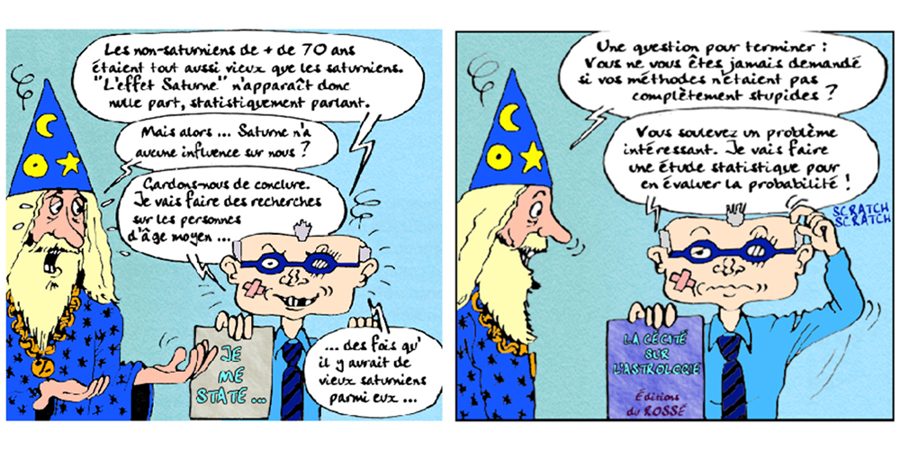
“Statistics, made by pro- or anti-astrologers, are devoted to the verification of traditional or modern assertions. The material is vast, unlimited, and the tool is not always up to the problem. If, in addition, the user is a novice or ill-intentioned — a little a priori is enough — the results are immediately felt” (Jean-Pierre Nicola, astrologer-researcher).
“How does the configuration of the sky at the time of birth determine character? It acts on man during his life like the strings that a peasant ties randomly around the squash in his field: the knots do not make the squash grow, but they determine its shape. Likewise the sky: it does not give man his habits, his history, his happiness, his children, his wealth, his wife… but it shapes his condition” (Johannes Kepler, astrologer-astronomer).
“The rewarding thing is to have a working hypothesis, to test it experimentally, and for it to be true” (Henri Laborit, surgeon and neurobiologist, who shamefully compromised with Élizabeth Teissier for unavowable media reasons without however being fooled, and without being pro-astrology for all that… neither systematically against either.
Here is what Michel Gauquelin wrote in his first book about his astro-statistics: “These results represent a considerable investigation with the aim of verifying the astrological rules on very large and very varied groups. It is necessary to penetrate the idea that these results represent a real demolition of astrology […], because it does not attack any author, but the most elementary bases of this doctrine itself” (emphasis added). Even if it is not devoid of a real but partial basis, it is first necessary to put a serious damper on this peremptory assertion.
It is absolutely correct that the results of his astro-statistics ruin most of the assertions contained in the vast majority of manuals of classical astrology or “traditional”, and in this Gauquelin is right. But he is wrong when he considers, without demonstrating it, that these data sources would expose the “the most elementary bases of this doctrine itself”. These works have in fact in common that they actually only offer descriptive theories of the astrological fact which originate partially in the Tetrabiblos of Ptolemy dating from 2nd century, were reworked between the 15th and 17th centuries and have hardly changed since. This constitutes an indisputable historical and epistemological reality.
Gauquelin therefore did not, through his statistics, ruin the elementary bases of astrological knowledge in itself, which dates back to millennia before the publication of the Tetrabiblos. What he effectively invalidated were the dogmatic or doctrinaire assertions that underlie the conception of so-called “traditional” astrology, which is very different. By way of comparison, what credit could be given to a researcher who claimed to invalidate the theories and practices of modern medicine based solely on the criticism of the medical conceptions of Hippocrate or of Galien? None. But that is precisely what Gauquelin did.
This important precision having been made, one could immediately expose what are the theoretical-dogmatic assertions called “traditional” which Gauquelin actually has “demolished”, and which resisted the onslaught of his statistical bulldozer.
But that would be ignoring what he has not tested, and which are nevertheless the two indisputable pillars of “traditional” astrology, namely the doctrine of the 4 Elements and that of Planetary masteries that are attached to it. The first, drawn and adapted from the Aristotelian vision of the world, constitutes the main theoretical foundation of knowledge and the obligatory reference of all astrological writings since the 16th century. The second, more specifically astrological, claims that each planet is associated with one or two Signs from which it draws strength or weakness. These two doctrines largely determine the influences and meanings attributed to the Signs as well as to the planets.
Why didn’t Gauquelin start by testing these doctrines? Because he had a naïve vision of science, close to an irrational empiricist belief, which made him prefer what he considered to be “facts” to theories, as if said “facts” were not realities produced by previous theories. And in this case, the “facts” Astrologies that he intended to test were not: they were only elements of a puzzle that he refused to consider as an organized whole.
This unreasonable but very understandable aversion of Gauquelin for theories being developed later, it is useless to dwell on it, except to point out that it prevented him from theorizing his own results, that is to say from understanding them. We will content ourselves here with observing that if he had statistically tested the validity of the doctrines of the 4 Elements and the planetary Masteries on the Signs, he could have undermined at the base the two theoretical pillars of “traditional” astrology. And of these two doctrines, one based on the Aristotelian conception of the physical world, the falsity of which has been observed and demonstrated, and the other on a characterized delirium of influence, there is no doubt that a statistical study would have shown insignificance. And perhaps even this demolition in order of these theories would have made it possible to see the emergence of “facts” unforeseen and significant statistics. But his quasi-childish anti-theoreticism caused Gauquelin to miss a relentless demonstration and the possible discovery of new “facts”. He would then have done a useful work which would have moreover significantly contributed to the kind of astro-glory which he sought.
This anti-theoreticism was also for Michel Gauquelin a fallacious but convenient pretext to prevent him from testing other hypotheses. Hypotheses based on contemporary astrological theories, which also produce “facts”, whose statistical significance he feared would overshadow his self-proclaimed status as “cosmopsychologist” then “neo-astrologer”.
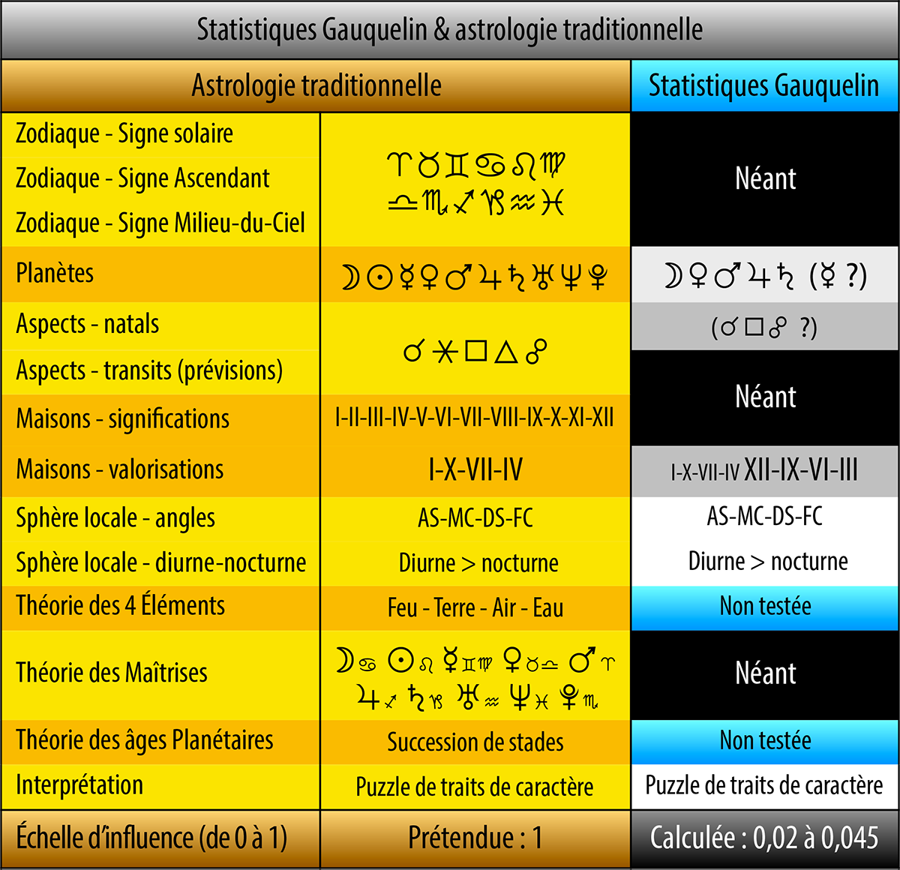
The summary table above also shows that these astro-statistics have not systematically “demolished” all the basics of traditional astrology. The demolition is certainly impressive but not total, contrary to what Michel Gauquelin asserts. On this field of ruins there still remain 5 Planets out of 10, the horizontal and meridian axes as factors of Planetary valuation, the precedence of the diurnal over the nocturnal and the puzzle of “character traits” attributed to the Planets retained by the statistical sieve. He therefore did not make a clean sweep of the astrological past-passive as he trumpeted in 1955. It was perhaps after finally agreeing that he declared this in 1983: “But today, I would not allow myself to draw radical conclusions, as I have sometimes done in the past. I would be content to simply be satisfied to have shed some light on this vast mystery which has occupied so many great minds over the centuries.”
For traditional astrology, however, there is nothing to be proud of. Suitbert Ertel summarizes it thus: “The link between Gauquelin and astrology is generally overstated. Gauquelin demolished most astrological claims, and the remaining link between astrology and planetary relationships is weak. […] The effect sizes are far too small to be useful, so the astrologers’ propaganda (that Gauquelin’s results support their ideas) is misleading. Informed skeptics will rightly see the planetary relationships as an interesting hiccup, but with insufficient potential to warrant further research. Nevertheless, future historians of science may be grateful for this example of the active interaction between a seemingly immovable anomaly and the unstoppable force of science.”
Those of the astrologers who relate to the current “traditional” variously welcomed these catastrophic results for their beliefs. Most of them have had only a very superficial knowledge of it, which they have generally not sought to deepen. The least well-informed and/or the most hallucinated took the Gauquelin astro-statistics for scientific confirmation of their beliefs. It has to be done… The table below gives you a brief summary of the diversity of these reactions. Note that non-traditional astrology, i.e. contemporary, conditionalist and natural, is in no way questioned or even directly concerned by the results of these statistics, which have tested neither its theories nor its practices.
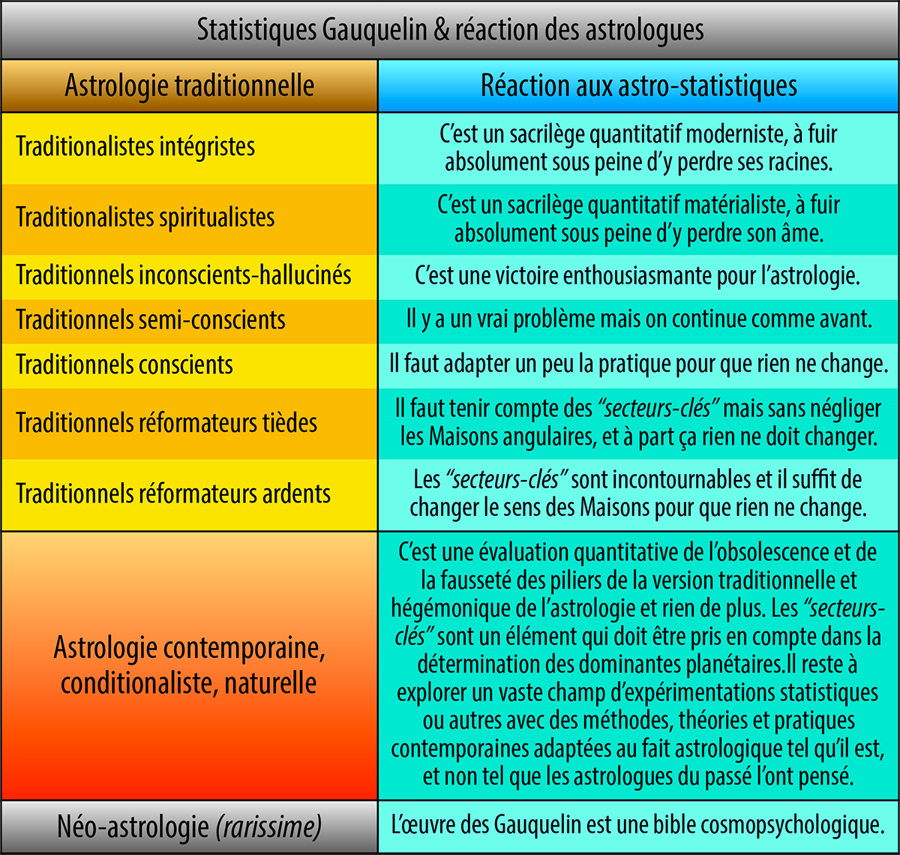
None. Regardless of the professional sample tested, no significant deviation from the theoretical average could be observed, whether for the Sun Signs, Ascendants or Midheaven, and these are the only hypotheses that have been tested. The Gauquelins also tested the Signs based on the most absolute assertions concerning them, which they obviously gleaned exclusively from the astro-symbolist literature. They therefore took as a data source, among other things, a list of generals of the Napoleonic Empire to check whether by chance there would not be an over-frequency of births under the Sign of the Aries, since this Sign is considered to be aggressive, therefore favorable to military careers, especially among high-ranking officers and as such “known”. The demographic corrections having been made, the Gauquelins realized that the generals of the Empire — and the others too — were neither more nor less Aries than the average.
Émile Zola, with a cluster of planets in Aries and yet not at all general, constitutes an excellent and sufficient counter-example, who wrote in I accuse: “They talk to us about the honor of the army, they want us to love it, respect it. Ah! Certainly, yes, the army which would rise at the first threat, which would defend French soil, it is all the people, and we have nothing but tenderness and respect for it. But it is not about her, whose dignity we precisely want, in our need for justice. It is the sword, the master that we will be given tomorrow perhaps. And devoutly kiss the hilt of the sword, the god, no!” It goes without saying that the Gauquelins tested the other eleven Signs with the same method based solely on profession, and that their statistics gave entirely negative results for the zodiac, which they consequently decreed had no no influence… contrary to that of their methods on their results as far as the Signs are concerned.
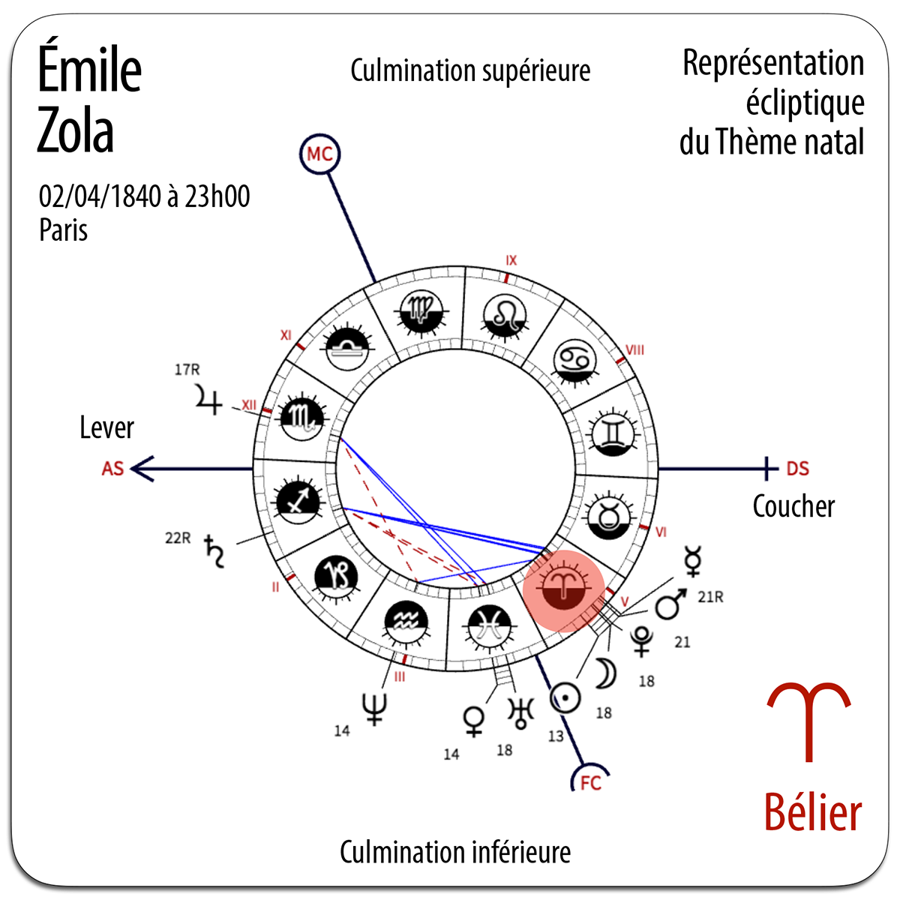
The Gauquelins had the idea of doing another zodiac test: it was a question of evaluating whether individuals with “character traits” Aries, who were extracted from the lexical frequencies concerning aggressiveness in their biographies, were indeed born more frequently than others under this Sign. Well, not at all: they preferred to be born (among other things) under frequencies of the Cancer significantly higher than the theoretical average! The Gauquelins did the same with the Ascendants Ram. Nothing. Ditto for the other 11 Signs. Nowhere do they mention if they studied the cases of individuals presenting clusters of planets in Aries while being born under another Sun sign and Ascendant, nor even what was for example the influence of Mars (Planet also decked out of “character trait” “aggressive”) in populations that had “character traits” Aries but who were born with a Sun in Cancer. This is what happens when you practice astro-statistics “cut out”. Françoise Gauquelin for her part had, all by herself, the absurd idea of testing the validity of the Doctrine of Planetary Masteries, which is completely goofy given the inanity of this one. Negative balance. She concluded that it was false. All it took was a little thought to do it, however, without the aid of any statistics.
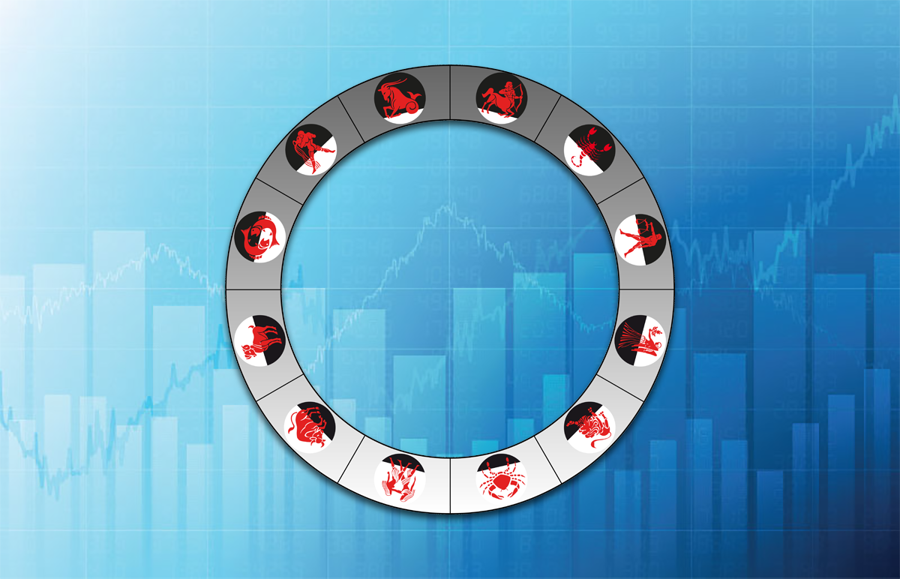
The method and assumptions on which the Gauquelins based themselves show that they understood absolutely nothing about the reality of the zodiac. Indeed, they proceeded as if the zodiac had a reality totally independent of that of the Planets. However, a Sign does not exist in itself: it is only a phase characteristic of the declinations of the Planets on or near the ecliptic around the terrestrial equator, these declinations inducing the cycle of variations of diurnal presence or nocturnal absence from the plane of the horizon, the effects of which vary according to geographical latitudes. In other words, a Sign is only a geocentric frequency of a planet and it is characterized by its declination and its ratio of diurnal/nocturnal durations.
This precise definition of the zodiacal reality means that the effects of a Sign cannot be apprehended without referring to the Planet of which this Sign is a phase of the journey. We can therefore only statistically test the effects of the Signs by testing the effects of the Planets at the same time. And to do this, one must first test the planetary effects according to the method indicated in the next section. We can thus initially determine the hypothetical effects of a set of Planets located in the key sectors “angular” without taking into account the Signs concerned by the Natal Charts of the statistical cohort thus studied. This having been done, we can then integrate the zodiacal factors into this study, by comparing the results obtained by two different cohorts composed of individuals with the same planetary dominants but different zodiacal dominants. This comparison would make it possible to highlight what belongs specifically to the Signs. Any other method can only be doomed to failure because of its inadequacy for the object under test.
It is likely that the sole criterion of professional success in any field will not produce any positive or negative results. By associating Planets and Signs, which is the only realistic way to evaluate the effects of Signs, we enter a zone of subtlety to which classical statistics cannot have access. Only assumptions based on tests of “character traits” very logical but also extremely sophisticated could be likely to confirm or invalidate the specific effects of the Signs by an appropriate statistical treatment.
As Jean-Pierre Nicola very rightly said, Michel Gauquelin “did not test hypotheses of the conditionalist type or the like. He specialized in the control of absolute assertions to show their inanity.” As far as the zodiac is concerned, he has done perfectly well.
In summary, it would have been surprising for the Gauquelins to validate the influence of the Signs of the zodiac based on such hypotheses which take up literally the most categorical and caricatural astro-symbolist assertions by isolating each time a Special sign. They would have obtained completely different results if they had carried out global studies on the prevalence, for example, Signs of excitation on Signs of inhibition connected to such or such planetary dominants. But to achieve this, they would have had to consider the Natal chart as a whole, in short, they would have to be conditionalist astrologers… which they never were.
Gauquelinian astro-statistics have only validated the influence of 5 planets (moon, Venus, Mars, Jupiter & Saturn) out of the 10 that astrology takes into account. The anti-astrologers thought that was too much; the astro-symbolists, not enough. Anyway, it was like for the zodiac of statistics “cut out” which isolated each time a Planet to study the frequency of its positions in the sectors of the local sphere in connection with a profession or with the method of “character traits”.
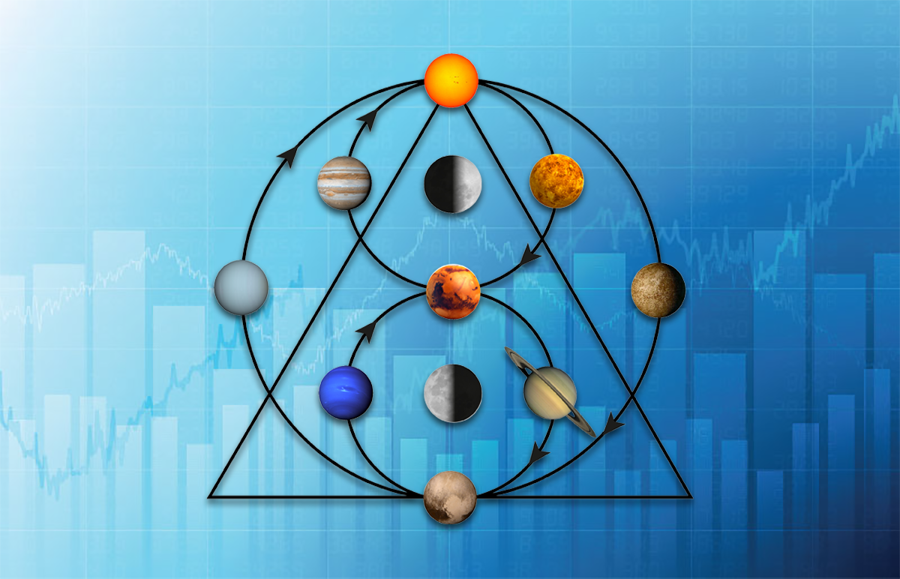
But the case of such an isolated Planet does not exist in reality. It always belongs to a set (that of the stars of the solar system considered efficient by astrology) or to a subset (for example that of the Planets called “angular” located in the “key sectors” of their rising, their setting, their upper and lower culmination).
Let’s assume that a statistical study only deals with this subset of the Angular Planets. In this case, an astronomical fact is statistically indisputable: it is very rare for a single planet to be angular. Due to the astronomical average of planetary distribution, variable according to days, months, years and centuries, the probability is much greater that two or more Planets are located in these key sectors. In this perspective, what must be the subject of this statistical study are all the natal charts comprising the same number of Planets and the same Planets in the same key sectors, and not a single Planet taken in isolation. And if we decide to study only the frequencies of a single Planet in one or more key sectors within a cohort, we must then retain only the sky charts comprising only a single angular Planet to constitute the base and control cohorts. If these conditions are not met and respected, such a statistical study will only be able to compare objectively incomparable data.
We can then, for example, apply to these cohorts the criterion of “character traits”, which is much more relevant than that of professional successes. The statistical study will then focus on verifying the relevance of the correlation between a “character trait” defined and the position of an angular Planet, if it is assumed that this “character trait” can only be associated with one Planet, which remains to be verified.
We will admit to begin with that the functioning of no individual can be reduced to a single “character trait”, even if it is the most salient and the most frequent in the more or less varied range of its observable behaviors. This is an indisputable psychological fact. Let us admit, however, that certain individuals identify themselves with a “character trait” so recurrent and dominant that it seems to eclipse all the other components of its functioning. In this case, the object of a serious statistical study should be to verify whether or not there is a significant correlation between the unique angular Planet associated with this “character trait”, And this “character trait” observable itself.
In the case of planetary multi-angularities, which are the norm, the approach becomes much more complex, at least as complex as the astrological, astronomical and/or psychological reality. The “character traits” peculiar to a single Planet are multiplying. Statistical verification becomes highly random if not improbable. And we understand better why, according to the studies of the Gauquelins, an individual born at sunrise or at the upper culmination of Mars has only a 33% probability of having a character “marsian” and 67% not to have it. The reason is simple: no one can be “marsian” at 100% or even only at 67%. And if an individual falls under a “marsian character trait”, he also always and at the same time raises other “character traits” associated with other Planets expressed simultaneously or successively in different situations, according to variable proportions in each individual according to his Natal Chart and his experience of it taking into account other astrological and non-astrological parameters.
What should therefore be statistically studied in the subset of planetary angularities is not a “character trait” artificially isolated attributed to a Planet that is also artificially isolated, but the set of “character traits” that can be synthetically attributed to the set of similar angular Planets within the same cohort of individuals that their Natal charts make representative of this configuration. Example: the trio Sun-Mercury-Venus can be defined by a set of “character traits” associates which is specific to it, and this set cannot be confused with the set of “character traits” associates that can be attributed to the trio Mars-Jupiter-Saturn. An adequate statistical treatment of these data would make it possible to highlight this difference. This operation is entirely feasible and all sorts of combinations and comparisons are possible.
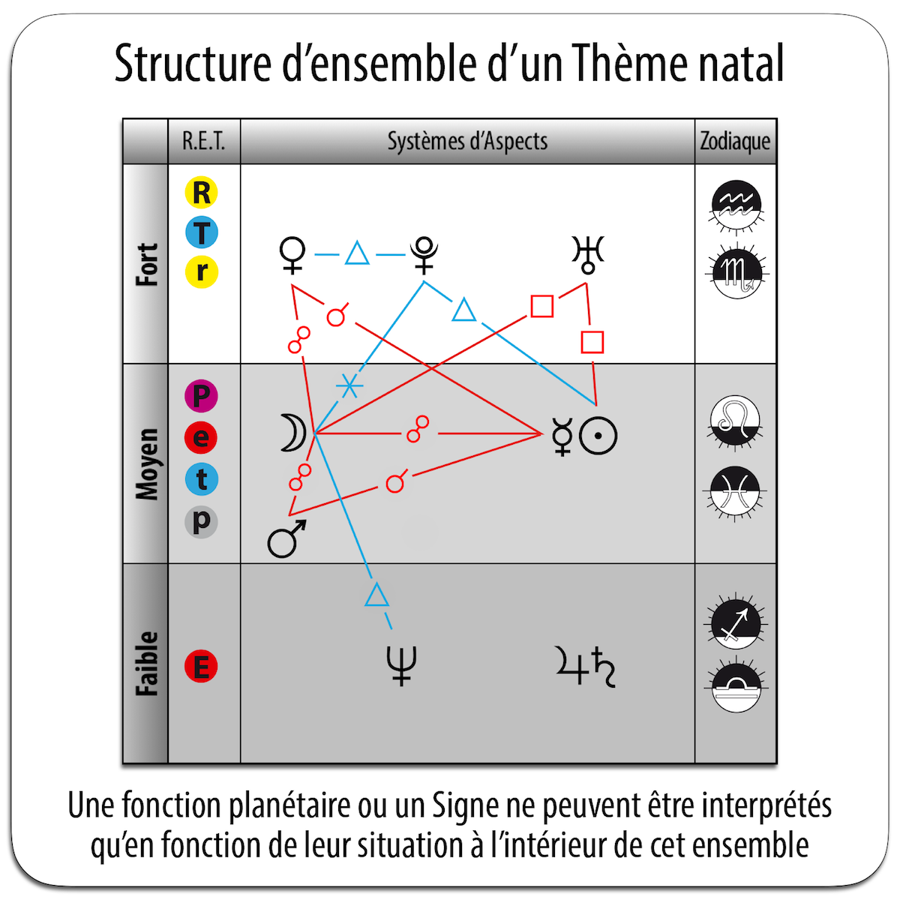
We are very far from the “Mars effect”, which, it should be remembered, only concerns the application of the criterion of professional success to cohorts of well-known sports champions. Note that in these, Mars is angular only in 22% of cases, which means that 78% of these champions are not “marsians”. The only statistical reality of the “Mars effect”, is that according to the laws of chance, only 17% instead of 22% of them should have been “marsians”. This difference between theoretical distribution and observed distribution is substantially the same for the other Planets statistically tested for other professions. This is not much, but sufficient to be considered an anomaly in relation to a theoretical average, and consequently to have allowed Gauquelin to play the neo-astrologer and to have incited cohorts of pseudo-skeptical scientists to indulge in fits of hysteria and anti-astrological cheating.
Now let’s review the negative planetary results of the Gauquelin statistics. moon, Sun, Mercury, Venus, Uranus, Neptune and Pluto were not initially recognized as capable of triggering professional success. Later the moon appeared to be more frequently angular among poets, writers and even politicians. In the statistics on the “character traits”, the lunar angularities have been confirmed and those of Venus appeared. But the results remained negative for Sun, Mercury, Uranus, Neptune and Pluto. Years passed, Michel Gauquelin died and his wife Françoise continued their research to see if she could not “save” other planets.
In a interview I had with Françoise Gauquelin, she confided to me that Mercury, which her late husband did not want to hear about, now seemed to her “the best candidate for late success. Twice already a serious researcher has communicated to me a significant result of angular Mercury.” She did not tell me how or according to what criteria. She died shortly after our interview. Would she have definitely admitted a “Mercury effect” If she had lived longer? It’s very likely. As I pointed out to her that she herself had an angular Mercury in the Ascendant and asked her if she felt “mercurian”, she answered yes. This is certainly not a statistician argument, but coming from him, it is not a fanciful or gratuitous answer either.
There is no need to elaborate on the case of the Planets which did not succeed in being retained by the statistician sieve of the Gauquelins, except to specify that the criterion of professional success associated with a Planet has shown its limits of relevance here. For these Planets, there is no doubt that positive results can be obtained by using other, more subtle criteria. Indeed, if certain Planets have a certain “effect” on human behavior, we do not see why and according to what criteria the others would be deprived of it, except to think that certain elements of an organized whole do not belong to this one.
In fact, it seems almost miraculous that the Gauquelins achieved significant results based on such an unquestionably crude criterion as professional success. It really has to be a subtly powerful astrological fact for such an unlikely thing to happen. But in doing so, the Gauquelins have only probed a tiny tip of a gigantic iceberg that still needs to be explored in its entirety.
It goes without saying again that if the Gauquelins had tested hypotheses specific to conditionalist astrology, they would have obtained completely different results, and this in particular by testing the planetary families “extensive” and “intensive”. But that was too much to ask of these two predatory crocodiles of the astro-symbolist backwater where they fed. I quote Jean-Pierre Nicola again: “Does Gauquelin have a theory? No. If he were a conditionalist, he would have rejoiced to see the confirmation of the power of the planets above the plane of the horizon. Then he would not have studied the professional groups without essential connotations on the social environment of origin. He could then have studied the percentage ratios between the jupiterian signatures fulfilling themselves in the deputation or the sport according to social origin and family means. Or, the percentage ratios between the signatures ‘Mars’ among male business leaders and the “others”, the “Mars” of the other sex… M. Gauquelin would then have done revolutionary work, edifying for all. The starting hypothesis — very hypothetically conditionalist — would have been refined or transformed. It would definitely collapse if the statistics showed no difference between a male and a female marsian business manager despite gender. In short, M. Gauquelin, do the ‘Mars’, regardless of gender, have an equal chance of becoming business leaders? You can imagine that I fear nothing for conditionalism!”
The Aspects are angular distances between Planets in the spatial reference or the characteristic phases of a cycle or an intercycle in a temporal reference. The results of the astro-statistical tests were all negative: according to Michel Gauquelin therefore, the Astrological Aspects would have no effect.
To arrive at this result, Gauquelin relied on four main studies which are in fact his own statistical refutations of studies by Choisnard. The first study involved comparing the Aspects formed between the Sun and the Moon with Venus, Mars, Jupiter, Saturn, Uranus and Neptune at the birth and death of thousands of illustrious deaths. The second dealt with the comparison of the Aspects formed between the Ascendant point and Mars, Saturn, Uranus and Neptune at the birth and death of half a thousand priests. The third dealt with the comparison of the Aspects formed between the Sun, the Moon and Mars, Saturn, Uranus and Neptune at the birth of more than half a thousand criminals. Finally, the fourth carried the comparison of the Aspects formed between the Moon and Jupiter at the birth of more than a thousand famous French doctors and during their election to the Academy of Medicine.

The starting hypothesis was therefore only to check the validity of two of the most stupid and caricatural assertions of mainstream astrology according to which 1) the precise date of death would be predictable and 2) the “transits” of Jupiter on the Moon would be consistently associated with socially rewarding deadlines. An experienced, observant and rational astrologer could have predicted to Gauquelin that the results would be negative and therefore spared him months of laborious calculations at a time when computerized data processing did not yet exist. It should however be known that it is only on these negative results that Gauquelin based himself to affirm that the Aspects had no effect, neither at birth, nor in the predictive domain, which is particularly stupid and arrogant.
After the death of Michel due to unpredictable suicide by astrology, Françoise relaunched herself in the statistical study of Aspects, convinced that their “professional results, showing strong areas at the four corners of the natal chart, necessarily produced ‘hard’ aspects (multiples of 90°) more frequently than average for very successful character births.” It is true that the Charts comprising multiple planetary angularities are more frequently than the others marked by angular oppositions (in the AS-DS or MC-IC axis) and a little less frequently by angular squares, for pure reasons astronomical.
Françoise Gauquelin, who was yours and yours with the small world of astro-symbolists, had the modesty of a dowager before daring to go to the end of this sacrilegious hypothesis (the oppositions and the squares pass for “malefic” in this place). I quote her: “I feared that this thesis would cause some turmoil […]. Our famous professionals had significantly more ‘hard’ than ‘soft’ aspects to explain their professional success. I will not go into the details of the controversies that this aroused, as expected. Personally I don’t think that this result really invalidates the traditions on the aspects. Distinguished professional success is not achieved on a bed of roses, and the ‘hard’ aspects fit well, in my opinion, in this situation. What matters here is that the violent controversy that followed my first result prompted several computer scientists to procure me all the control groups necessary to prove and re-prove several times that my first result was sound. This incidentally taught me that the theoretical astronomical frequencies are incredibly agitated, irregular for the aspects.” This last sentence also proves that Michel Gauquelin had never done any real research on the Aspects apart from those relating to the predictability of death, contrary to his assertions.
Concerning the Aspects, Françoise Gauquelin simply ended up recognizing that the dissonant Aspects, far from being “malefic”, only indicate tensions, and the consonant Aspects, relaxations which have nothing either “benefic” in itself. It all depends on what you do with your tensions and relaxations. If the Gauquelins had taken into account the conceptions of conditionalist astrology on this subject, they would never have sought to test the character “malefic” or “benefic” aspects. But with the Gauquelins, it was always like this: what they sought to validate statistically was never the complex reality of the zodiaco-planetary influences, but the discourse that the astro-symbolists held on them. It is a bit like a statistician deciding to test the validity of medicine based solely on the theories and practices of Diafoirus father and son, pedantic and charlatanesque doctors in Molière’s play Le Malade imaginaire.
It is necessary to distinguish between the meanings traditionally attributed to Houses, considered by astrologers to be “expression fields” specific to the zodiacal-planetary effects, of the influence attributed to them as factors in the hierarchy of the same effects.
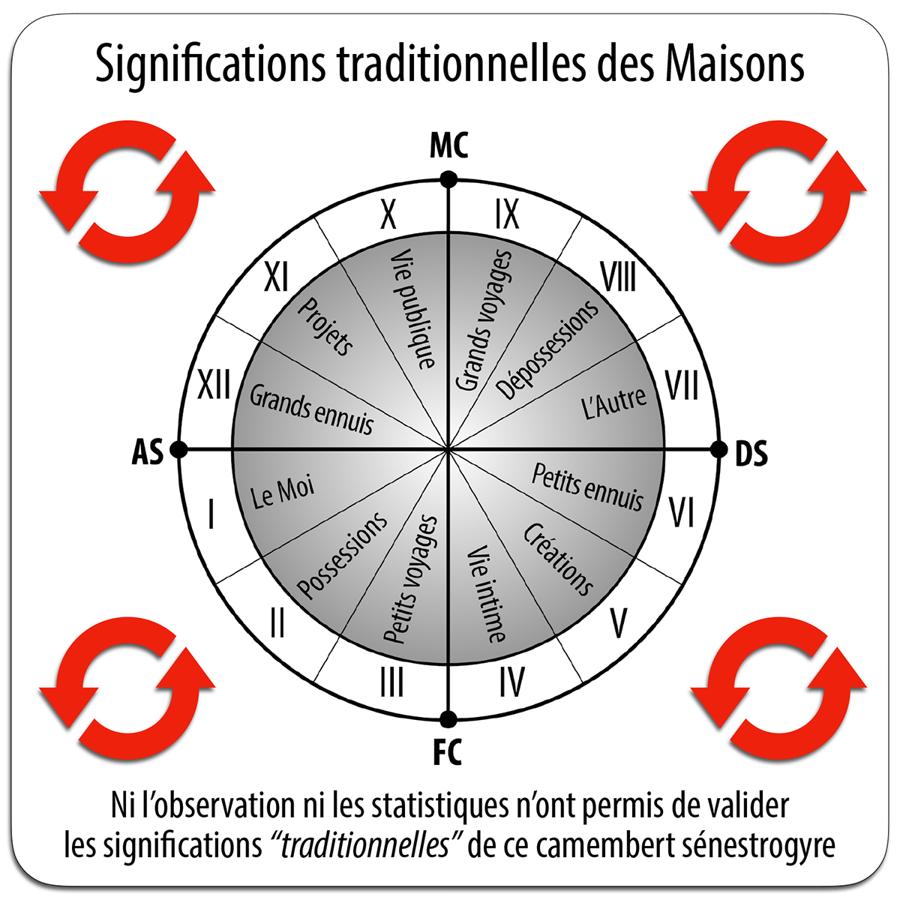
According to Michel Gauquelin, the meanings attributed to each House are invalidated. He did not give details of the hypotheses he tested to arrive at this negative result, which constitutes a methodological fault on the part of this lecturer. One can nevertheless suspect him of having been as lax on this subject as on the treatment of the problem of the Aspects (see above). Even if he had detailed these assumptions, it certainly would not have changed anything about the negative results: the meanings traditionally attributed to the Houses resemble an irrational Prévert’s inventory that it is impossible to test other than by psychedelic methods.
The Gauquelin statistics have moreover partially invalidated the influence of the Houses as factors in the hierarchy of planetary powers. Classical astrology indeed claims that the 4 “angles” of the local sphere (rising & setting on the horizon, upper and lower culminations at the meridian) and the Houses “angular” I, X, VII and IV which are immediately consecutive to them in the sinestrogyral direction were the most rewarding sectors for the Planets which were located there.
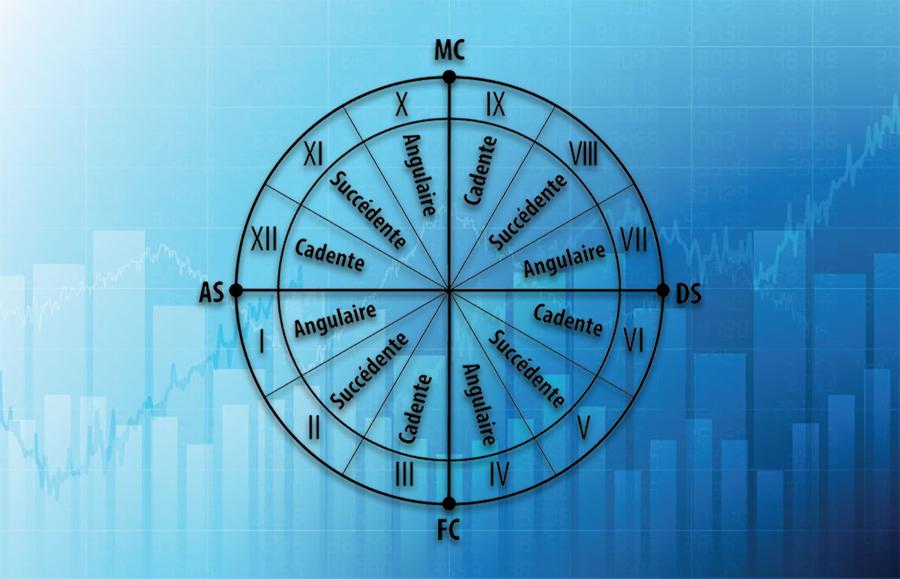
Gauquelin statistics confirmed the importance of the 4 “angles” but invalidated the globally rewarding character of the Houses “angular”. The most influential Houses are according to these studies the XII, IX, VI & III, therefore those which are immediately consecutive to the 4 “angles” in the dextrogyrate direction.
These results had the effect of a bombshell among astrologers, in that they deeply questioned the importance that the dominant tradition attributed to the Houses “angular”, supposed to strengthen the planetary influence as much as possible, and the Houses “cadent” which precede them and which are supposed to weaken the Planets which are located there as much as possible. But they came as no surprise to those familiar with other traditions and other previous statistical research, as well as the more observant astrologers among practitioners, who had long since spotted this phenomenon. The history of these observations and theories concerning the Houses as hierarchical operators of the planetary powers is exposed to you in the section dedicated to the Houses following the review of the Gauquelin statistics.
It should be noted, however, that the extent of “key sectors” gauqueliniens evolved during his research, data accumulating and years passing. The first version (was it a statistical coincidence or a deliberate will?) took the exact opposite of the Angular Houses “traditional” (that’s to say actually post-Ptolemaic, as we will see in detail below). But the second, which we find for example in his book The Dossier of Cosmic Influences (1972), expanded the range of these sectors at the end of Houses I, X, VII and IV in the direction of daily movement. For the clarity of the presentation, it is necessary here to reproduce the successive graphs of the “key sectors”:
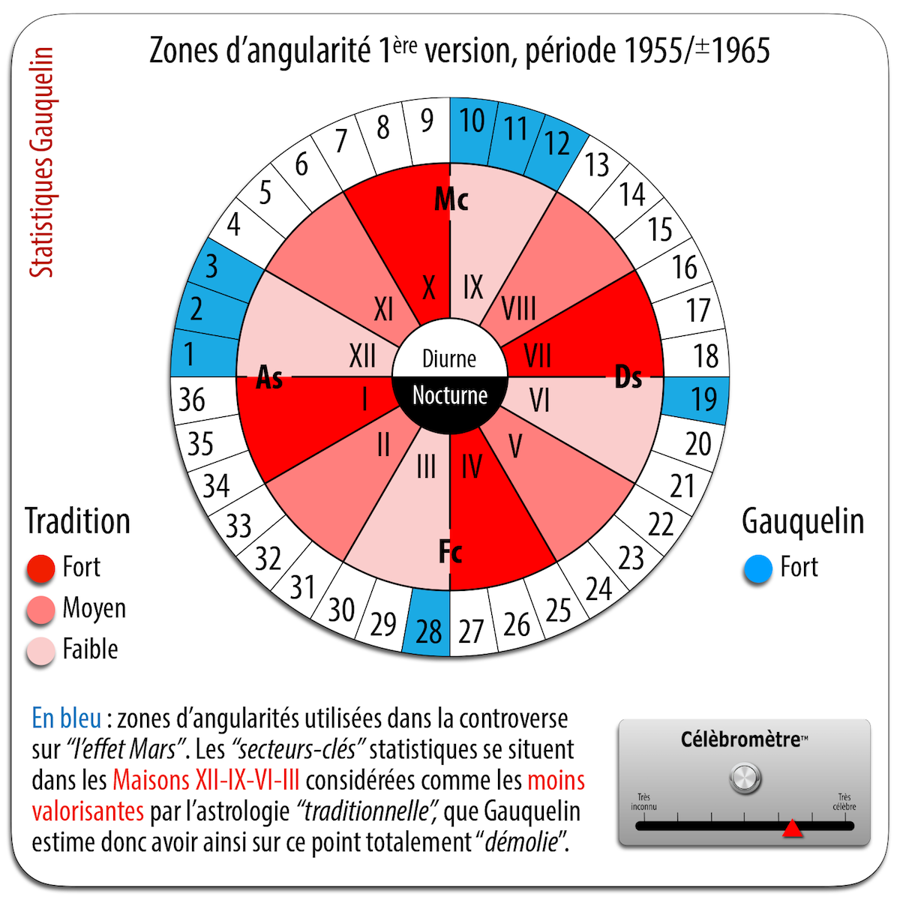
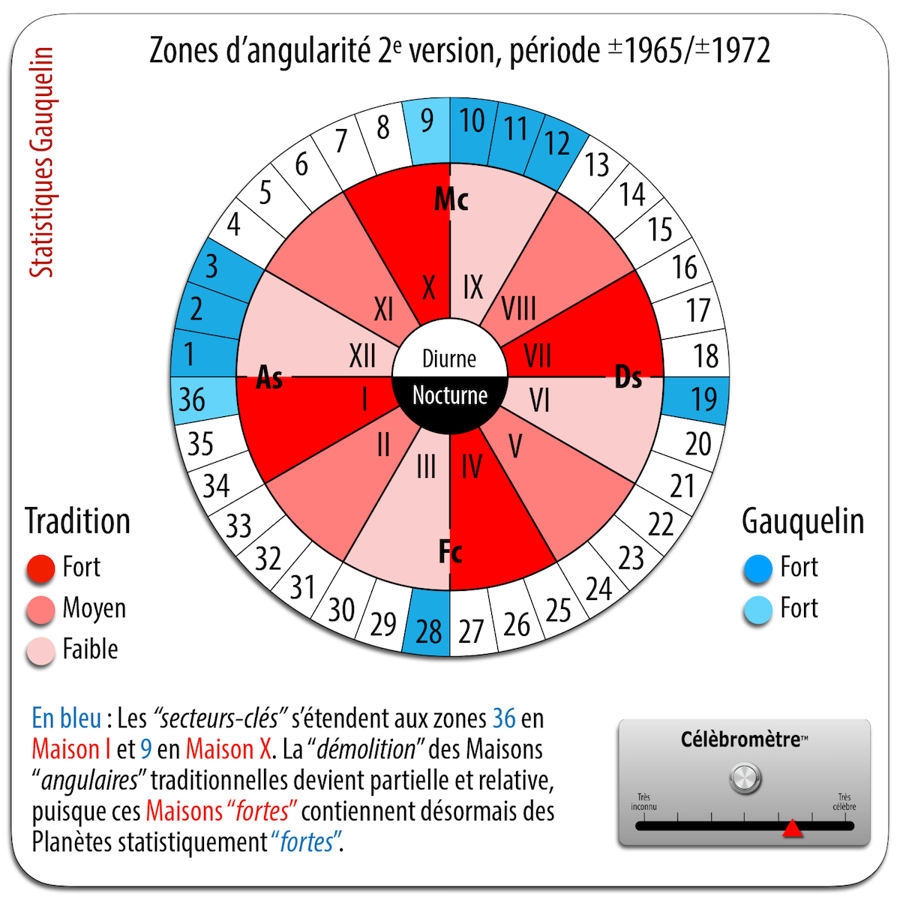
Moreover, some of his interpretations of Celebrity Charts in this and subsequent books show that he takes liberties with the scopes of “key sectors” of the DS and the IC, which he does not hesitate to overflow largely in Houses VI and III and a little less in Houses VII & IV. He once confided, towards the end of his life, that his statistics gave more significant results if he enlarged these areas as he had previously done for the “key sectors” of the AS and the MC. We find in 1985 a graph of the same type as the one below in the French version of the book by Françoise Gauquelin Psychology of the planets, except that the extensions in Houses VII & IV are not included. At Michel Gauquelin, this would correspond to a graph similar to this one:
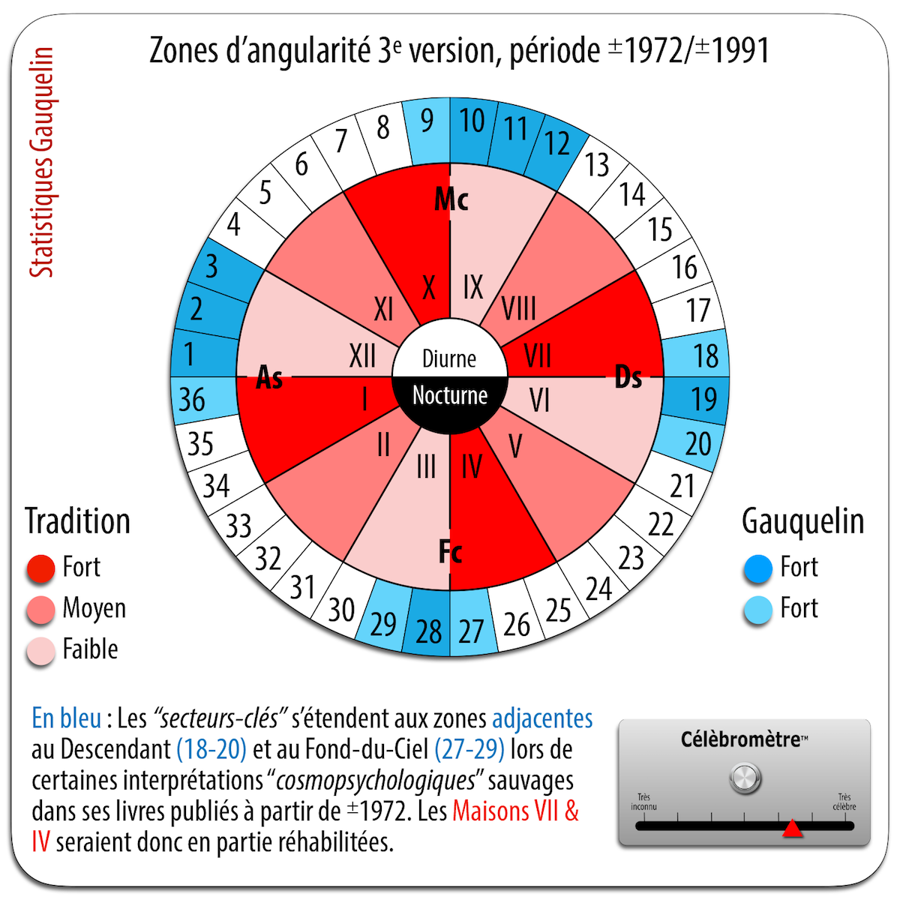
But back to the book The Dossier of Cosmic Influences. We find pages 108 & 109 a portrait of Eleanora Duse, Italian actress considered as an example of an actress “modest” and therefore non-jupiterian saturnian. The angularity of Saturn in its Natal chart is not in doubt. A photo of her appears in this paragraph and, to the left of it, there is another, that of Brigitte Bardot, both of which are captioned with a single sentence: “Bardot and the Duse: two generations of actresses but also two different meanings of life.” Which suggests that Bardot would be the opposite of a Saturnian “modest”, otherwise, why attach the photos of the two actresses when the Chart of Bardot is not interpreted?
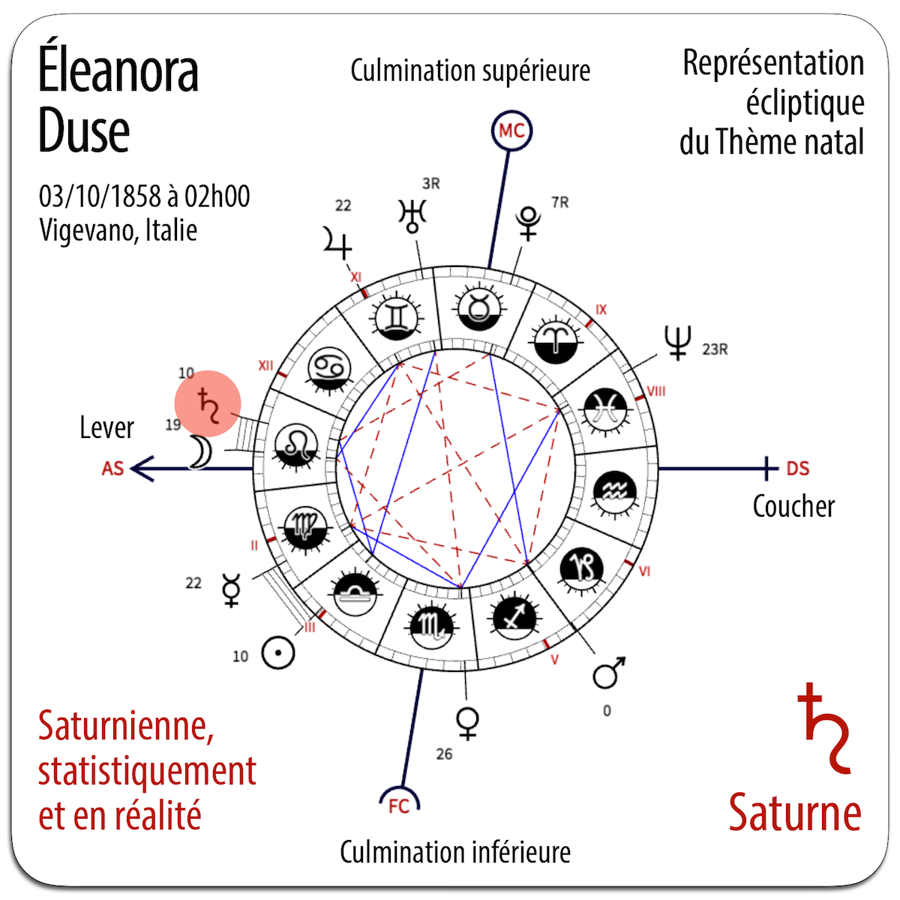
Indeed, Bardot is not saturnian… but according to Gauquelin statistics she cannot be jupiterian, given that Jupiter is in sector 8, certainly close to its upper culmination, but outside the “key sector” from the MC. And his birth time (12:15) not being round, it is probably quite exact. Nevertheless, one cannot help thinking that Michel Gauquelin had the temptation to make her a Jupiterian all the same, by astral symmetry with the Duse… but that he ended up giving it up, prisoner of his rule.
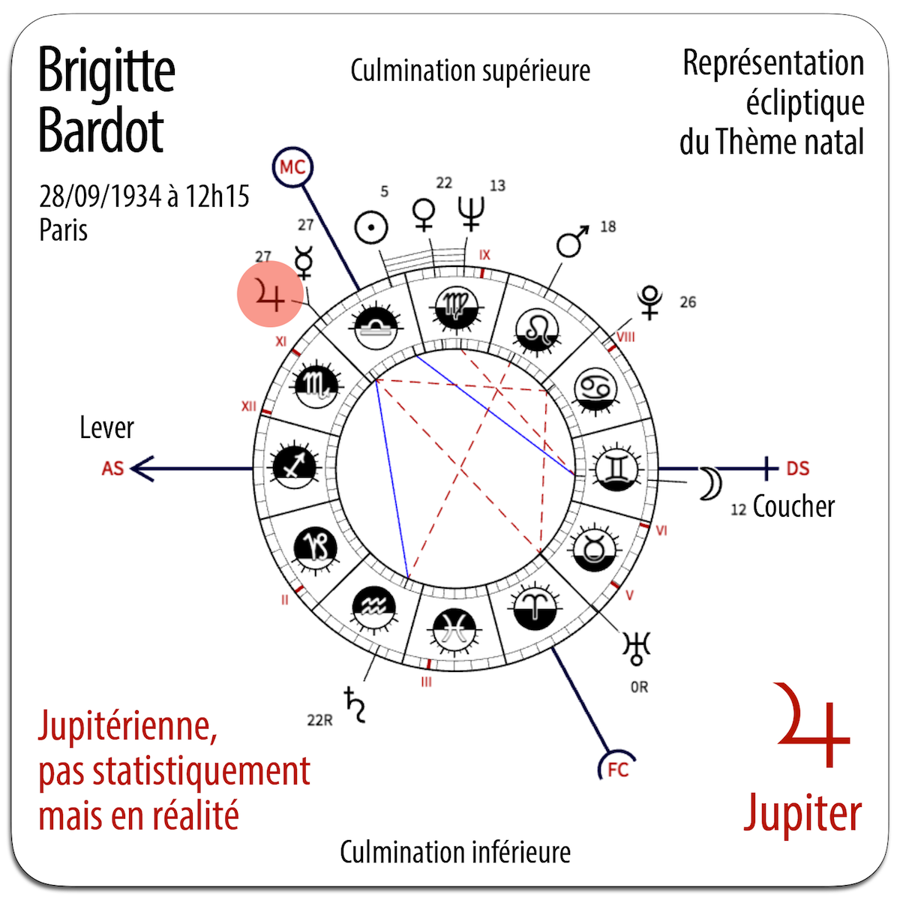
To console him posthumously, the 36 sectors of his statistical grid can be rotated by 10°, which corresponds to a time correction of –40’. His “key sectors” concerning births between 1800–1950, therefore comprising a very large number of very imprecise and generally rounded hours, and knowing that the roundings are almost always done to the higher hourly unit, this rectification is not abusive. This senestrogyrate rotation has the result of making Brigitte Bardot a Jupitero-Mercurian, which suits her like a glove. And the same rotation makes this chart (below) look amazingly… like the conditionalist astrology chart that is the basis for determining the angular Planets of our software Astrosoft !
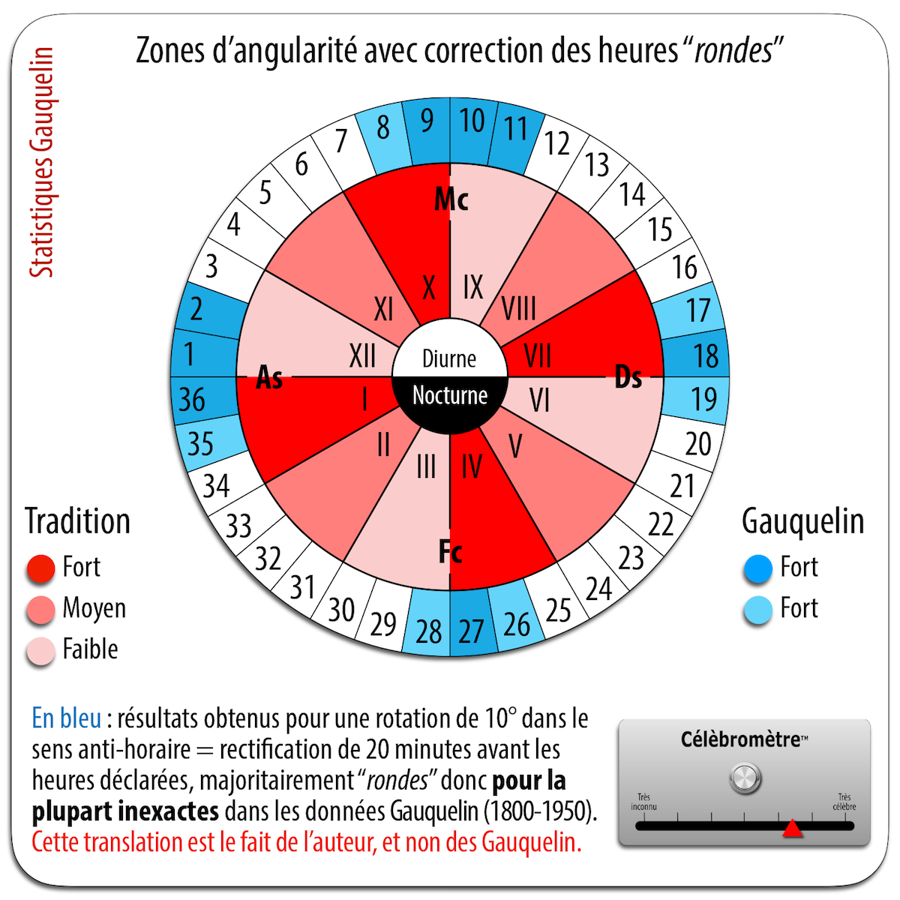
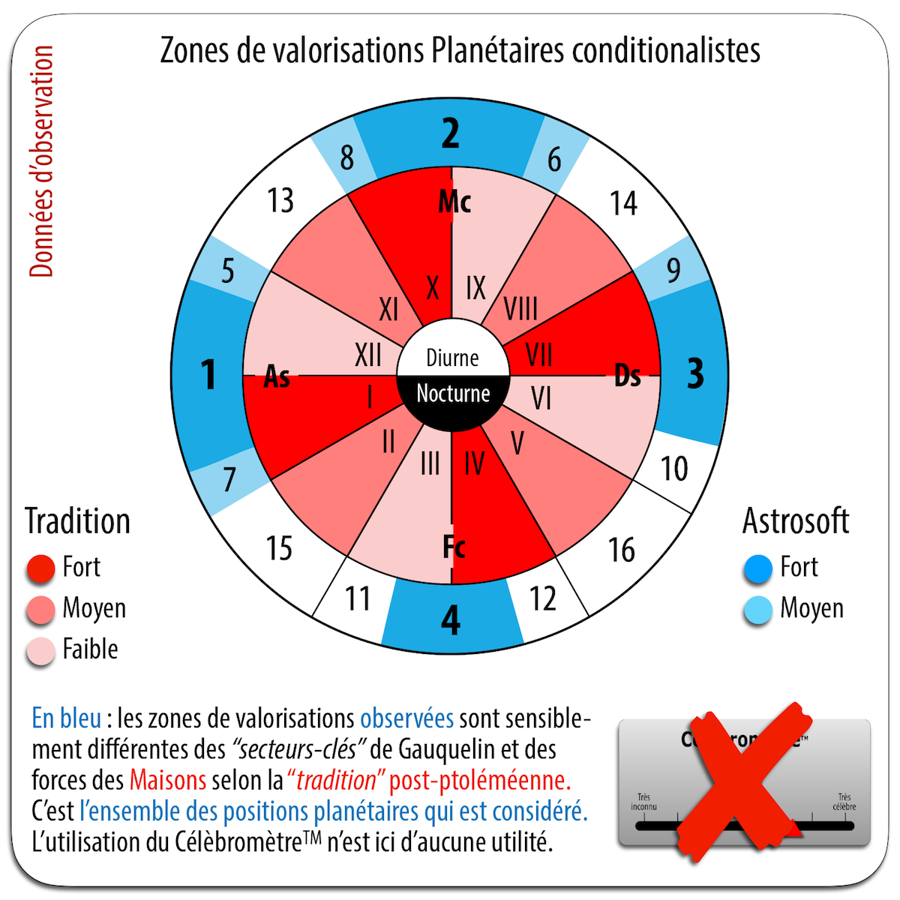
Another positive effect of Gauquelinian statistics was to validate that the diurnal arc (above the horizon) had an effect “exciter” which reinforced the relative powers of the planets, while the night arc (below the horizon) had an effect “inhibitor” which diminished these. The astrological influences being a homogeneous whole, the Gauquelins thus validated in spite of themselves (they never realized it) the conditional photoperiodic zodiac, based among other things on the times of presence and absence of the planets above the horizontal plane which is directly indexed on the north and south planetary declinations.
In the mid-1960s, the Gauquelins carried out a statistical study on the comparison of the horoscopes of parents and their children, based on the criterion of “character traits”. They believed that if the father or mother were born under angularities of Moon, Venus, Mars, Jupiter or Saturn, their children tended to be born more often than other children with the same planet in the same AS zones, MC, DS & IC, and that this frequency, of rather low amplitude, doubled if the two parents had the same planetary angularity in the same zones. So there would be a “planetary heredity”, the effect of which would gradually diminish from generation to generation.
They also found that this “planetary effect in heredity” tended to disappear in medically induced births. More exactly, this planetary effect persisted, but with a significant shift in the planetary angularities common to parents and children. There would therefore be a connection between genetics and astrology, the baby choosing in a way to come into the world the moment of the passage of a planet in a zone of angularity similar to that of the same planet in the sky of its parents. The Gauquelins drew the wrong conclusion because it had not been demonstrated that babies born during induced deliveries did not come into the world under their “true” horoscope, but under another, decided by the obstetrician. This obstetrically programmed horoscope would not correspond to their character, but it is only a hypothesis which has not been statistically tested, nor the future profession of these babies “statistically biased”.
This first statistical study was the subject of a 2nd replication with different cohorts. The deviation from the mean of the observed frequencies always had a very small amplitude. This very small gap did not prevent Michel Gauquelin from making “planetary heredity” a pillar of the new astro-statistical science he recently calls “cosmopsychology”. In all the books he wrote thereafter, a very important chapter was devoted to him. Indeed, he believed that “planetary heredity” constituted his most important discovery in that it established a bridge with genetics and therefore science. And precisely, Gauquelin dreamed and aspired to be recognized as a great scientific discoverer…
But contrary to what he did for his statistical results on planetary angularities and professional groups, he was careful not to ask scientific committees to control and reiterate those concerning his “astral heredity”: he knew very well that the deviation from the mean of the frequencies he had obtained was much too small for it to be considered significant. Moreover, no anti-astrologer committee sought to replicate these two studies on its own initiative, which is very curious given that such a replication would almost certainly have invalidated the alleged “law of astral heredity” of which Gauquelin gargled.
A 3rd subsequent replication did not yield significant results when it involved a population double that used for the first two studies, which it should therefore have very clearly confirmed if “astral heredity” actually existed.
A study was carried out in 1990 by Suitbert Ertel, statistician, professor of psychology, skeptical but open to the unknown so not very suspicious of being a priori anti-astrologer. Made from a very small cohort of 110 professional celebrities being part of those already used by the Gauquelins, its purpose was to try to determine whether the latter had not been conscious or unconscious victims of “confirmation bias” in the correlations they had established between planetary angularities and “character traits”. The result showed that this was indeed the case. At least that is what Suitbert Ertel concludes, despite the fact that his own study only covered too small a number of individuals for it to be considered significant by orthodox statisticians. And from this statistically insignificant conclusion, he inferred that the alleged “law of astral heredity” was only an artefact, not only because the deviations from the mean on which it was based were too small, but also because it was also based on “confirmation bias” of the “character traits” parents-children identical to those on which it also rested. Michel Gauquelin died shortly after the publication of this study, which did not allow him to set out in detail his objections to the study by Suitbert Ertel.
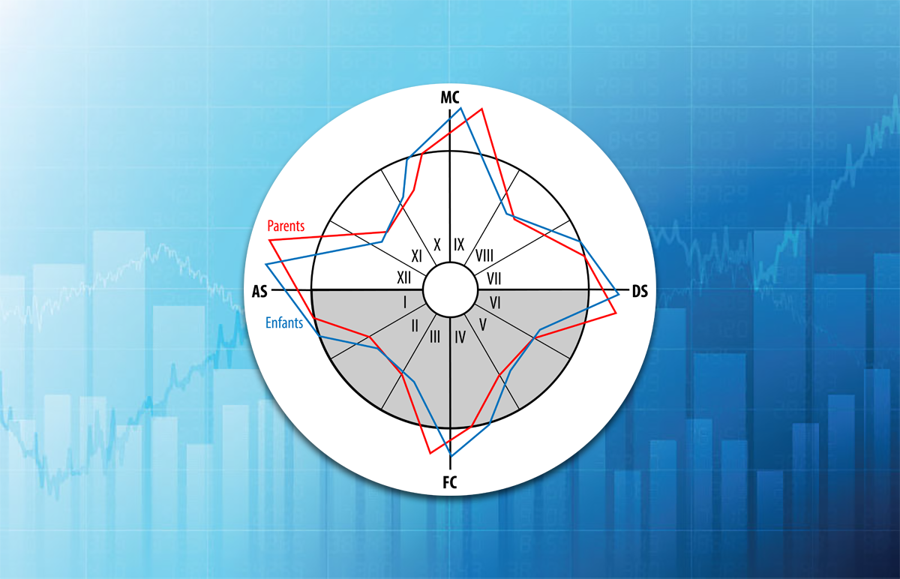
The alleged “law of astral heredity” was therefore probably only an artifact, a false discovery. Its invalidation shows that we must beware of drawing hasty conclusions from small deviations from the mean, especially if these are the results of an initial hypothesis too likely to be undermined by “confirmation bias” as was that of “character traits”.
This false discovery nevertheless raises important questions: would it be the baby who “would choose” his time of birth in order to be born statistically under astralities quite frequently identical to those of his parents? His birth time “real” Is she the one that is biologically programmed by this phenomenon of astral heredity, or that of the moment when she leaves the uterus, whatever the natural or induced conditions of her birth? Michel Gauquelin was also alarmed by the systematization of artificial deliveries, which risked eliminating this “planetary effect in heredity” and, with it, the whole “neo-astrology” of which he considered himself the neo-pope. But it seems that the disappearance of this “planetary effect in heredity” being an artifact artificially caused by the increasing accuracy of reported birth times throughout the 20th century. This highly probable hypothesis is developed in a later section.
In an attempt to answer, at least partially, these questions, I am obliged here to set out my personal observations. As part of my astrological consultations, I have always asked my consultants to obtain the birth times of their nuclear family members. I have never observed any systematic similarities between the Parent and Child Charts. Moreover, with regard to the time of birth, it very often happened to me (especially at the beginning, when I did not systematically request verification of the accuracy of this data from the Civil Registry), in speaking with my consultants, to note that what I perceived and analyzed of their psychological functioning did not correspond to the Chart set up according to the time they had given me. I then interrupted the consultation, told them that this time was probably wrong and that they should therefore check with the Civil Registry. Of course, there are exceptions to this rule. It happens that the officially declared time is totally erroneous, but this is relatively rare… and there too, it is something that can be spotted quite easily in consultation, provided that you have a good sense of psychological observation and capable of good astrological deductions. It is sometimes in the memories of the mother that the hour of birth is found “true”.
But it turns out that almost every time I was right, and that their “true” natal time, the one that allowed to draw up a horoscope corresponding to their observable functioning, was the official one or the one corrected by the mother or a participant in the delivery with a good memory. This also concerned all individuals, whether they were born before or after 1960. It therefore seems that the time that matters is that of leaving the uterus, whether the birth is natural or planned. Of course, these personal experiences and observations relating to less than a hundred cases are not comparable with statistics relating to thousands. The conclusions that I draw from this remain provisional and do not ignore the possibility of a phenomenon of “astral heredity” of very low amplitude which could be disturbed by induced deliveries.
The problem comes down to asking, in the case of births not artificially induced, whether it is the baby who triggers natural childbirth, or his mother, or the mother-child couple. This question is still debated. During the 19th century and into the 1st third of the 20th, the scientists asserted that it was the mother and her alone who “decided” unconsciously of the moment of the expulsion of the future newborn. Then opinions changed and this categorical assertion fell out of fashion when it was discovered that it was likely that it was the fetus that was sending chemical messages signaling that it was ready to exit the uterus. The new doxa therefore made the fetus the childbirth decision maker.
It was during this period of the baby-king that the Gauquelins formulated their hypothesis of astral heredity. The hypothesis of the baby being the sole decision-maker of his extra-uterine discharge suited them well: he is the one who “was choosing” naturally to be born under the horoscope that suited him to resemble his parents, which is a very conservative and simplistic conception of the family… And if the deliveries were artificially induced, that meant that the baby was no longer born under the planetary configurations which “corresponded”, but under those that the obstetrician had chosen for him, and which did not “corresponded” so no. This lack of “correspondence” allowed the Gauquelins to justify the discrepancies in the planetary positions between the charts of the children and the parents and to save the interpretation they had made of their first results by attributing to the obstetric interventions the subsequent results which deviated from them.
But during the second half of the 20th century, the doxa of parturition changed again. This time, it was the mother-child couple who were seen as the equal co-decision makers of the timing of natural childbirth. This new approach hampered the Gauquelins in their conclusions: if the baby was no longer the sole decision maker of his horoscope, if the birth horoscope was the result of joint co-decision, the hypothesis of a horoscope “natural” of which the future newborn would be the only agent disappeared. If the mother and the fetus worked together to effect the expulsion, this meant that the intervention of an obstetrician, who could hasten or delay this moment, was no longer a crime against the “neo-astrology”, and the newborn’s natal horoscope was just as valid whether the time of birth was naturally or artificially programmed.
The Gauquelins’ research into astral heredity nevertheless had the positive effect of asking a crucial question and trying to answer it: when are we born? Birth is indeed not an instantaneous phenomenon, but a process that starts from the time of the first contractions until that of the expulsion of the baby. Other crucial questions: do we live better with our natal horoscope, do we integrate it better if the birth was natural than if it was artificially programmed? Is it possible that artificial deliveries cause us to be born under horoscopes that do not “correspond” not or even, as Michel Gauquelin claimed, who have no influence on us because they disobey a hypothetical “astral heredity”? Which amounts to asking other questions: what is the relationship between heredity and astrological influence? Does heredity alone decide, at the level of the mother-child couple, of a time of birth which would correspond to a hypothetical horoscope “natural”? Or the complexity of the phenomena in relations and interactions which act on the childbirth does it allow adaptive flexibility of which the intervention of an obstetrician is only one of the factors?
It is difficult to answer these questions. It is not impossible that there is a probability of discrete transmission of characters “astro-genetics” generals, but this one has absolutely nothing certain. These are vast continents that remain to be explored. We’ll leave it at that for now. We will remember from all this that it is essential, in order to do all this research, to have reliable birth times.
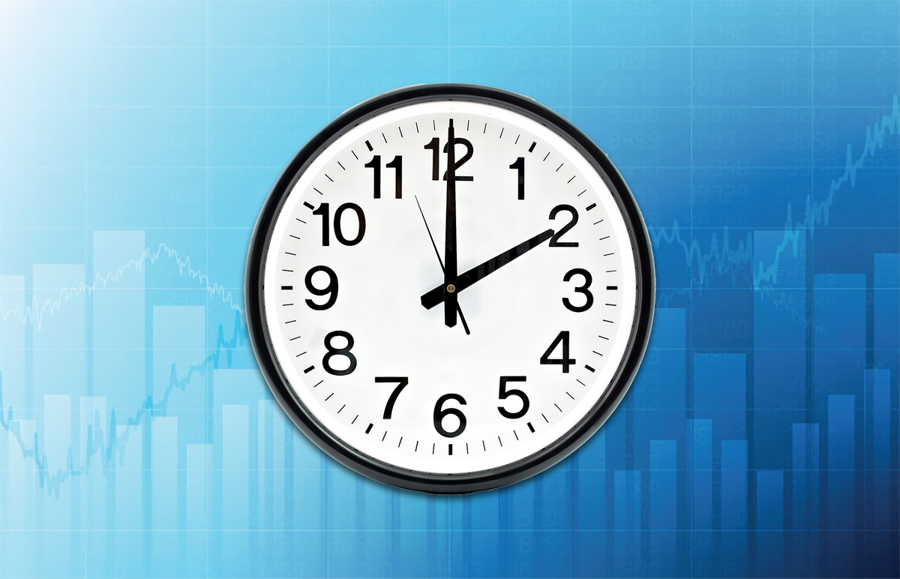
These statistical searches depend on the accuracy of the birth times indicated by the Civil Registry. of a statistical study carried out by the astrologer Patrick Le Guen and relating to 1165 hours declared to the EC (Civil Registry) between 1800 and 1970, it appears that:
▶ from 1880 to 1910, the frequency of “round hours” or “striking hours” (e.g. 09:00, 12:00, 21:00) is about 80%.
▶ from 1910 to 1930, this frequency increases to about 60%
▶ from 1930 to 1960, it rose to about 35%
▶ from 1960 to 1970, it was only around 17%.
In almost a century, we have therefore gone from 80% of people who were born to “round hours” at 17%. What happened?
An average accuracy of ten minutes before or after the birth time is usually sufficient for the astrologer: during this time the sky hardly changes in most cases. We can thus cut a 24 h day into 10’ slices. According to this breakdown, one hour “round” has an exit probability of 1/6, which corresponds to a frequency of 16.66%. Whatever the year of birth, there should therefore be on average between 16 and 17% of people who are born at times “ringing”.
This output frequency is observed only for birth times recorded from the sixties onwards, which alone can on the whole be considered very reliable. The time frequencies of previous years are “abnormal”. It remains to explain the reasons for this anomaly. It’s quite simple: until the end of the first half of the twentieth century, for various reasons, very little importance was attached to the accuracy of the time of birth. An individual actually born at 16:45 ou 16:35, for example, could very often be declared born at 17:00. Moreover, we know that, for psychological reasons, most of us prefer (non-commercial) boroughs to the higher unit, which is a “more”, while the lower unit is a “less”.
It is striking to observe that as the rural populations emigrate to the cities and as medicine progresses (increasingly systematic intervention by midwives, more and more frequent births in hospitals provided with very precise clocks), the frequency of “round hours” tends to approach the theoretical average.
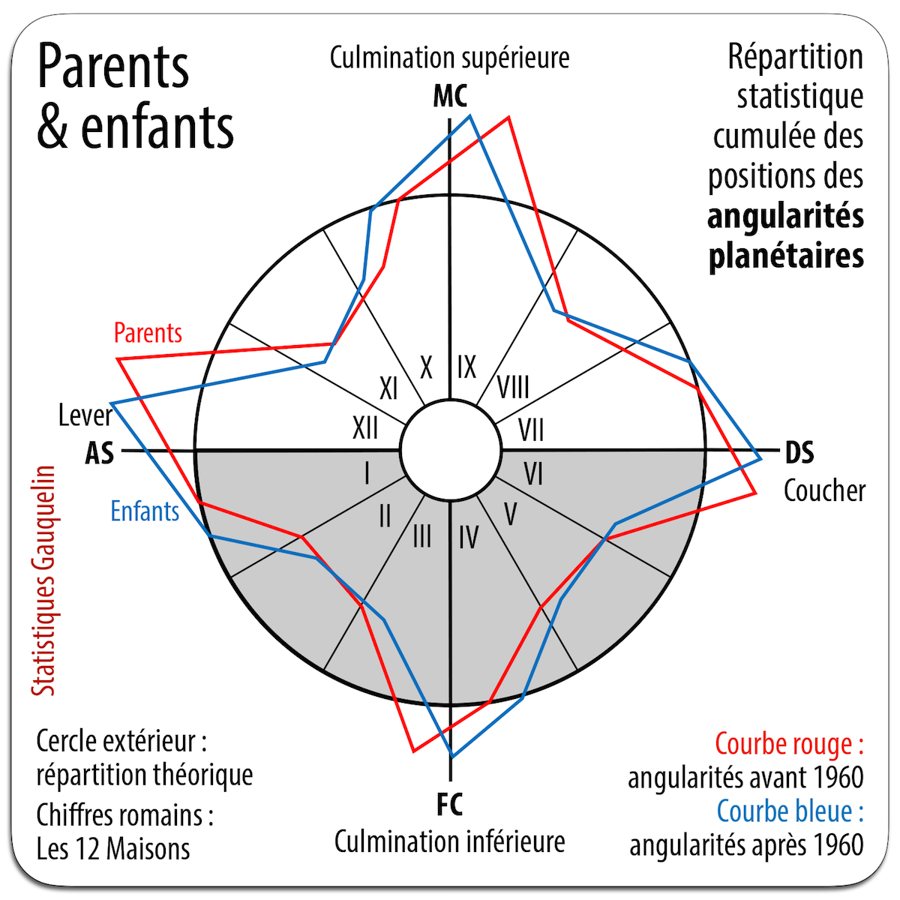
The figure above, produced and adapted from the statistical work of Gauquelins, illustrates the shift in planetary angularities in parents (born before 1960) and children (born after 1960). In the parents, the imprecise hours tend to push the zones of angularities towards the Houses XII-IX-VI-III; in children, the precise times show that the zones of angularity cover the four “Angles” of the local sphere: the gap between the zones of angularities “traditional” and statistics decreases as the time precision increases. This means that if we redid all of Gauquelin’s studies based on populations born in France from 1960, the statistical model would most likely be much closer to the model “traditional” than the Gauquelins believed.
This also demonstrates that the discrepancy in angularity between the charts of the parents and those of their children noted by the Gauquelins is not due to obstetrics and induced deliveries, but most likely to the increasing accuracy of birth times. It is therefore more the clocks than the forceps that are at stake in this affair…
Having statistically established in the 1960s that there was a correlation between certain professional successes and certain planetary positions in the local sphere, the Gauquelins embarked on another kind of study, this time based not on the trade, but on the “character traits”. Astrology attributing to each Planet a fairly precise influence on human behavior, they sought to demonstrate that this correlation could be statistically validated or invalidated. To do so, they relied on two sources of documents. The first was composed of biographical descriptions devoted to professional celebrities, the second of astro-psychological descriptions devoted to each Planet, drawn from a large number of manuals written by the most famous astrologers.
From biographical and astro-psychological descriptions they systematically extract adjectives and phrases concerning “character traits”, whose occurrences they then determined statistically. Then they undertook to compare the results obtained by the two documentary sources, in correlation with the planets statistically correlated with the various professions. They entered the field of psychology, where the pitfalls of confirmation bias are all the more numerous as the qualitative takes precedence over the quantitative and the vagueness over the precision.
The Gauquelins never made the effort to conditionalize these “character traits” astrologically determined by contextualizing them, that is to say by associating them with other extra-astrological parameters that influence behavior and psychological functioning. However, genetic heritage, sex, morphology, state of health, intellectual level, spiritual stature, education received and/or acquired, learning, lived experiences, socio-culture, etc., and of course the entire Natal Astrological Chart, are all variables that modify the expression of “character traits”. One can even add to these various determinisms the degree of bullshit, which does not appear in the birth horoscope and which constitutes an essential prism filtering all the tendencies of a personality, among astrologers as among anti-astrologers.
The results they obtained after appropriate statistical treatments of these data confirmed that there was a significant and positive correlation between the “character traits” the most frequent in the biographies of celebrities of the same profession and the “character traits” most frequently attributed to the Planet(s) correlated with this profession. It was then that the Gauquelins decided to give their astro-statistics the name of “cosmopsychology”.
These positive results, according to them, were never the subject of a systematic refutation on the occasion of replications conducted by anti-astrologer scientific committees, which alone the “Mars effect” seemed to excite. The only counter-expertise was conducted by Suitbert Ertel in 1990. It led him to affirm that the positive results obtained by the Gauquelins suffered from significant confirmation bias. But this counter-expertise itself had its limits, since it only covered an insufficient number of data to be considered statistically significant.
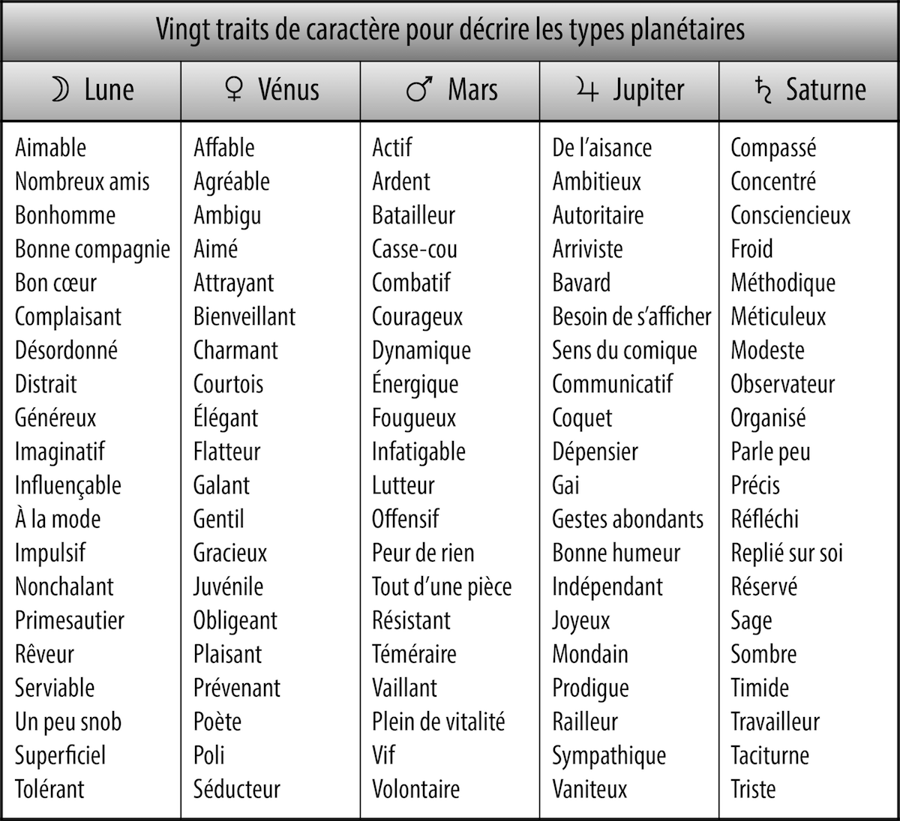
The method used by the Gauquelins to determine the “character traits” associated with the Planets demonstrates once again and without any ambiguity that what they attempted during 45 years of hard work was not to try to statistically validate hypothetical astrological effects, but to test the absolute assertions contained in astrology manuals written by famous astrologers, either to demonstrate their overall inanity, or to confirm the relevance of some of them. It’s a bit like if a doctor, to determine the state of health of a patient, applied his stethoscope to a general medicine manual rather than to the chest of this patient, and this without knowing if this manual was written by a competent doctor or by a charlatan. It is simply ubiquitous.
The biographical data, in principle devoid of any astrological trace, from which are extracted “character traits”, are themselves questionable sources. They only concern famous people in their field, and the biographies of celebrities, which are rarely written by psychologists considered competent, are always accompanied by hagiographic temptations which inevitably distort the descriptions of “character traits” that they contain. They are therefore not in themselves reliable sources. They require to be very strictly controlled and verified by referring to other testimonies, especially if they have been produced by journalists, peers friends or enemies of these celebrities, on the occasion of obituaries or during welcome speech by a new member with the obligatory eulogy of the previous occupant of his seat in various academies.
The data extracted from the astrology manuals selected by the Gauquelins are also unreliable, and it is the very criterion on which this selection was made that is in question. This criterion is indeed exclusively that of the celebrity of the astrologers who wrote these manuals which are therefore the most sold, not because of the quality or the relevance of their content, but because of the notoriety of their authors.
However, this criterion of commercial celebrity is perfectly inadequate and even profoundly stupid, since it in no way sanctions a skill. It is even exactly the opposite in the field of astrological publishing as in many others: commercial success does not generally go to the best or the most competent, but to those who best meet the expectations of the target audience. And it is even more obvious in the field of astrology where swarm hucksters, charlatans, debtors of obsolete recipes, supporters of various “schools” and others ignorant and incompetent in the matter they claim to represent.
If we exclude this brood — which the Gauquelins did not — we could retain (according to what indisputable criteria?) only the few honest and apparently serious representatives of what is called “scholarly” astrology who still managed to make a name for themselves and sell quite a few textbooks. Alas most of them only refer to conceptions of astrology dating from 2000 years ago, which they have more or less brought up to date using a more modern vocabulary, and adapted to currents and astrological schools to which they relate and according to the degree of traditionalism or pseudo-modernism which characterizes them.
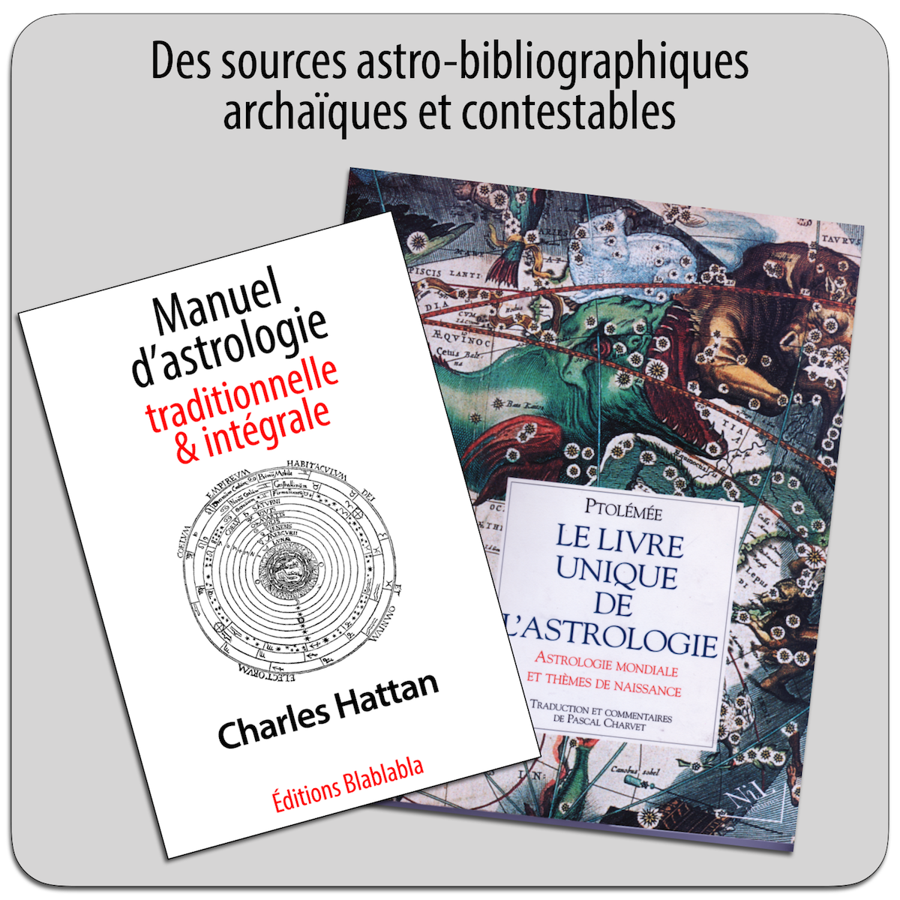
It is from this heterogeneous set that the Gauquelins extracted their data in the form of a list of “key words” most often attributed to each Planet. Françoise Gauquelin notes on this subject, in her book La Psychologie des planètes, than a keyword “given by a single astrologer is most often contradicted [by Gauquelin’s features]”, whereas a keyword given by “more than one astrologer… is most often confirmed”. In reality and on average, 44% of these keywords corresponded to the planet concerned, 22% concerned another planet, and 34% corresponded to nothing. Moreover, this remark by Françoise Gauquelin shows that she was in full confirmation bias. Indeed, the fact that a keyword given by a single astrologer is most often contradicted does not necessarily mean that this astrologer is wrong, but can also mean that the “character traits” that Michel Gauquelin has drawn from lexical occurrences drawn from the motley mass of best-selling astrology textbooks are perhaps largely irrelevant. A single competent and learned astrologer may very well be right against all these lists of “character traits” Gauquelinians. Quantity, especially when it comes to sales volumes of astrology textbooks, is not synonymous with quality. It’s quite the opposite.
And this, the Gauquelins knew very well, because of their assiduous frequentation of astrological circles. They were therefore guilty, not of a simple error of assessment in the choice of the criterion of celebrity and the related commercial fallout, but of a very serious ethical fault coupled with a monumental confirmation bias.
This is all the more obvious since they knew perfectly well that they could test their hypotheses based on the writings of serious and competent astrologers, whose existence they knew very well. They would then have really demonstrated a daring scientific spirit. Some of these serious and competent astrologers offered them to do statistical studies. The Gauquelins have never acceded to their requests and have always answered them with silence or an end of inadmissibility.
The famous and hegemonic traditional or traditionalist astrologers, competent or not, scholars or charlatans and whatever school they claim, all the same have one thing in common: all refer implicitly or explicitly, in their writings, to an interpretation of planetary effects that dates back to 2nd century and which has evolved very little since, and all of them more or less mirror each other. It is therefore logical that the statistical treatment of the occurrences of “key words” shows a certain unity in the meanings attributed to the Planets. And since these meanings have a certain degree of relative relevance, even if they are for the most part simplistic, dated and often caricatural, it is not surprising that the studies of the Gauquelins, however imperfect, fragmented and simplistic they are, have thus partially validated these traditional meanings.
The fact remains that what the Gauquelins tested was not the effect of a planet on human behavior deciphered by contemporary and competent astrologers who offered them non-verbal tests to validate or invalidate their proposals and hypotheses, a proposal which they refused. What they actually tested was what a majority of backward-looking astrologers wrote about the effects of this planet in popular works that on the whole have a very low standard.

It goes without saying that the Gauquelins would have obtained much more relevant and decisive results if they had not been obsessed (especially Michel) by fame, whether it be their own, that of the professionals to whom they have devoted their statistics and that astrologers who served as their reference. This obsession with glory was particularly devouring in Michel Gauquelin. She had him write in 1965, when he was just beginning his astro-statistics, that the “new scientists who seek to understand the relationship of the heavens with the Earth” would see their names featured “in the Larousse of the 21st century”. Needless to say, in his celebrity-starved mind these “new scholars” were reduced to one: himself.
This deliberate choice of celebrity induced by professional success as the supreme criterion for selecting representative cohorts has, moreover, been at the center of all the debates and controversies between Michel Gauquelin and the various anti-astrologer committees. Fame is indeed a very difficult thing to quantify. Where does mere fame end? When does real fame begin and how long does it last? What physical, socio-cultural or intellectual feats must one have accomplished to be able to access it and thus benefit from public attention? From what extent of media coverage, from what number of biographies devoted to him, can an individual be considered truly famous? How to measure the excess implied by fame?
Remarkably, all of the critics of scientist contemptuous of the “Mars effect” focused on this central topic. The most lenient anti-astrologists suspected Gauquelin of bias a priori data by setting the fame slider either too high or too low. The most severe accused him outright of cheating by placing this slider exactly where it suited him to obtain the desired results. The worst of the latter, and they were legion, even decided that the slider which discriminated in a certain vagueness between the unknown and the famous, the least and the most famous, was only an arbitrary measure which we could do without, which was a height of pseudo-skeptical absurdity. But the rather lenient as well as the moderately severe anti-astrologers faced the same problem as Gauquelin himself: where to draw the line between celebrity and non-celebrity? They had exactly the same difficulty in defining it with indisputable criteria. And some of them, such as Kurtz, intended to take advantage of the “Mars effect” to become famous in their turn…
By placing the celebrity cursor very high, that is to say by selecting only the known and recognized elite of hyper-celebrities, Gauquelin exposed himself to having only a small number of cohorts and therefore statistically insignificant and likely to be subject to numerous astronomical or demographic biases. And anyway, the limit between small and big celebrity is just as difficult to locate.
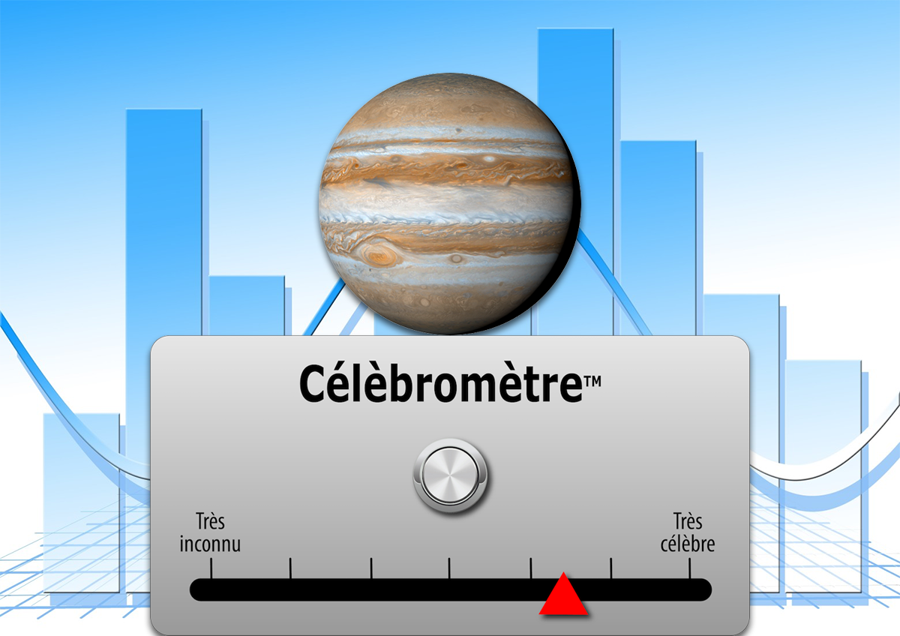
Many of his scientistic adversaries therefore accused Michel Gauquelin of cheating by placing the notoriety slider at a level allowing him to obtain the desired results. The bitter insinuations after his suicide even show that some of the most shameless cheaters did not shrink from the supreme accusation: according to them, as we have seen, he killed himself because he feared — for his fame? — that a gigantic cheating of which he would have been the author for almost half a century is revealed. The spread of the false rumor that he asked the man who saw the man who saw the bear to destroy all its data would be the most flagrant proof of this.
This accusation is not only false, but also absurd. Michel Gauquelin has never shied away from the requests for replications and second opinions from his scientific adversaries, and it is even very often he who has been in the position of plaintiff. He has always shared his data with them, and they have used it extensively. You really would have to be a stupid and inconsequential cheat to act like that for half a century in a field where checks are so easy and punctilious, moreover having opponents whom he knew would not do him any favors. Moreover, Michel Gauquelin wanted to be famous — fame, always! — and renowned as a great scientific discoverer. And for that, he had to be as flawless as possible in his experimental protocols.
His most lenient scientific opponents have merely accused him of resorting to subjective bias in his cursor positioning choices between unknown and known, celebrity and non-celebrity. They were very probably right, all the more so since in nearly half a century of research, it was brought to change more or less the positioning of this cursor inside the evolutionary zone of the knowable which is between the known and the unknown of knowledge in general, or between the fame and the anonymity of professionals in the particular case that interests us here. But he always faithfully communicated information about it. In the final phase of selecting representative cohorts, his scientific opponents systematically tried to move the slider so that the results of their replications of the “Mars effect” minimize it or invalidate it by making it insignificant. Michel Gauquelin was then obliged to defend himself, and his defense was not always free of confirmation bias… just like the attacks of which he was the object, which all suffered from denial bias.
You may have noticed that the author of this article cannot be suspected of wanting to defend Michel Gauquelin at all costs. The cause he defended was anything but that of a intelligent and well-understood contemporary astrology of which he has always been a declared opponent for one reason only: he feared that she would overshadow him. However, the few meager but unmistakable results he has obtained nevertheless deserve to be defended.
As the American jurist, writer and academic rightly pointed out Daniel J. Boorstin (1914–2004), a celebrity is mostly “a person known to be well known”. The same Boorstin (which has nothing to do with the “Mars effect”) is notably the author of The Discoverers, a wonderful book in which we can read this sentence: “The main obstacle to discovering the shape of the Earth, the continents and the oceans has not been ignorance, but the illusion of knowledge.” It really took the expanse of the astrological continents and oceans to see very vast for the Gauquelins to discover a tiny part of them, when they were only equipped to do so with far too many illusions of knowing something about it. thing and relying only on the compass of the most famous and best-selling astrologers.
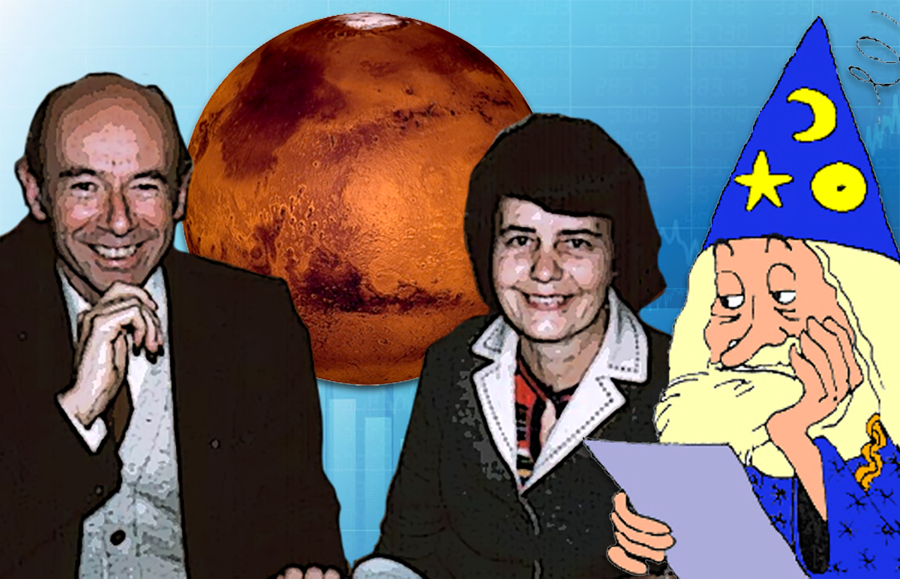
At the end of this critical presentation, it remains to make a quick assessment of the astro-statistics of the Gauquelin couple. To do this we quote Jean-Pierre Nicola: “I insist on the fact that one must be extremely careful, both for positive results and for negative ones. Not out of refusal or doubt, but because the pitfalls in these matters are, statistically, very numerous. It was in full knowledge of the causes and effects of statistical methods (think of polls) that I dissociated myself from the hasty enthusiasm of the magico-symbolists carrying Gauquelin like a spearhead against the scientist wall. The wall exists, in depth and in width. But a truly scientific mind knows that statistics have no demonstrative virtue. […] With regard to statistical methods, the conditionalist position has always been clear: it takes verifications, it takes a lot of them, to challenge them, to control them, to remake them with new ideas and with an explanatory theory s improving according to the results. Conditionalist astrology leads to a vast field of statistical experimentation, but M. Gauquelin has no attraction for them: it is not his role to test hypotheses that risk being positive for astrology. We have yet to wait for a statistician at least as concerned with truth as with personal success […].
The Gauquelin statistics confirm the increase in the planetary effect in the diurnal course of the star, its decrease in the nocturnal part of its daily cycle. Increase in effect also when the earth’s magnetic field, in correlation with solar activity, gains in intensity. […] Original results to be checked: the role of transits in the diurnal movement (angularities of the planetary dominants) during prenatal pain and spasms precursors of death […]. Astro-statistics has an insufficient record for a scientific theory of astrology, but undeniable for the affirmation of a physical and natural relationship between the sky and men.
M. Gauquelin’s astro-statistics highlighted the influence of five planets on the group of ten used by astro-psychology. By other works, the author established for Moon, Mars, Jupiter and Saturn four planetary temperaments likely to combine between them […] The biographical and clinical analyzes of conditionalist astrology show the errors and insufficiencies of such a keyboard. Like symbolist astro-psychology, statistics does not refer to variables other than those contained in the horoscope, disconnecting the receiver from conditionings including a Kepler however, has been widely reported. In this sense, astro-statistics is an anti-symmetrical reflection of symbolism: false accomplices and false enemies, the protagonists speak at least of the same thing, the absolute horoscope. So the antagonism is resolved when it comes to not hearing conditionalist astrology.”
We will also retain from the astro-statistics of the Gauquelins a notorious refinement of the zones of valuation (risings, sunsets, upper and lower culminations) and of planetary non-valuation of the local sphere. The general profile, whatever the frequencies, has the shape of a four-pointed star which is superimposed on the horizontal and meridian axes.
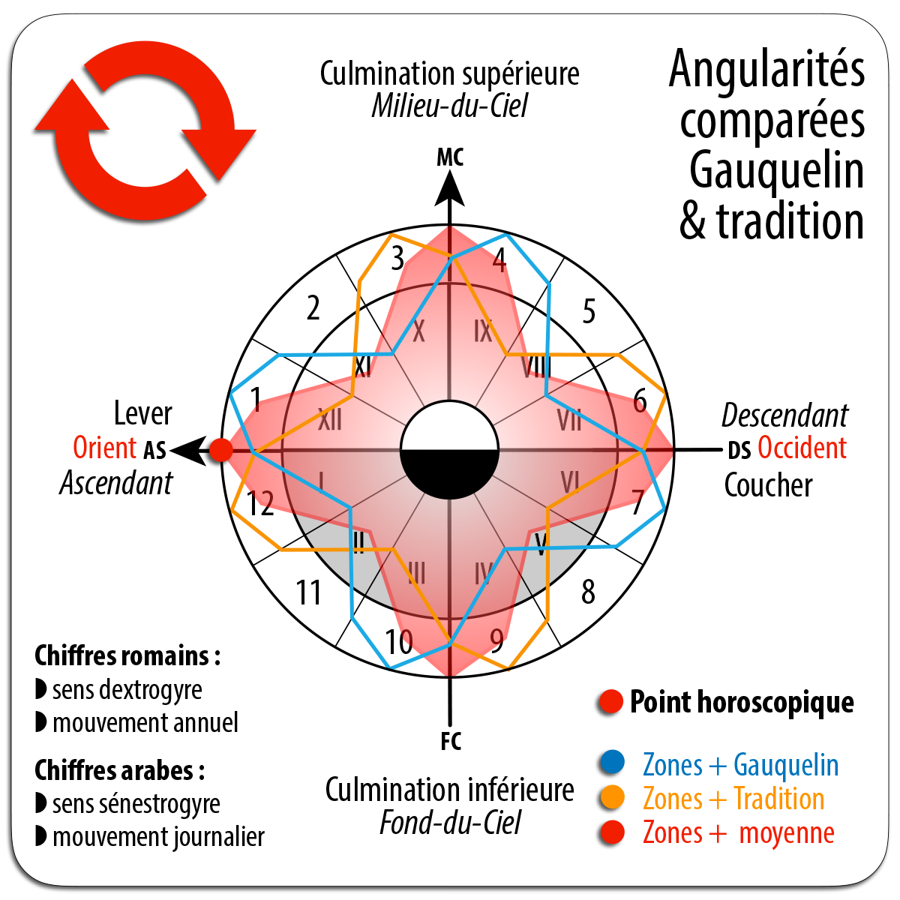
In addition, it will be recalled here that following a computerized analysis of his data in 1984, Michel Gauquelin concluded that all the effects of planetary angularities were clearly confirmed statistically if one included the zones located just before the “key sectors”… which amounted to widening the “Gauquelin areas” in Houses I, X, VII & IV “traditionally” considered as rewarding by the astrologers he booed. That, the conditionalist astrologers knew it without making statistics relating to tens of thousands of cases: the practice and the direction of the observation were enough for that. This is a capital contribution to astrological knowledge. From now on, there is no longer any serious method of evaluating relative planetary powers that does not refer to the results obtained by Françoise and Michel Gauquelin.
Indeed, even if the deviation from the theoretical mean was a little lower than the 10 to 25% determined by the Gauquelin statistics — or if the effect size was a little less than 0.045 — the demonstration is made that There is a qualitative difference between, on the one hand, the planets close to the horizon and the meridian, and on the other hand those which are not. If we consider the local sphere as a space within which the Planets are distributed, we will consider that it is a phenomenon characteristic of a anisotropy spatial (property of an object relating to its dependence on any direction). An anisotropic space is thus structured according to the orientation of its parts. If we consider that the same local sphere is a spatial representation of a temporal scheme concerning the daily cycle of the Planets, the same phenomenon will be characteristic of a temporal anisotropy relating to the time of passage in horizontal and meridian zones. It is the statistical demonstration of this effect of spatio-temporal anisotropy that matters, and not the significant extent of the deviations from the mean in itself. It confirms the observations of astrologers of the pre-Ptolemaic past as of the present, and must serve as a basis for any serious method of hierarchizing the planetary powers… and any research on the biophysical foundations of astrological effects.
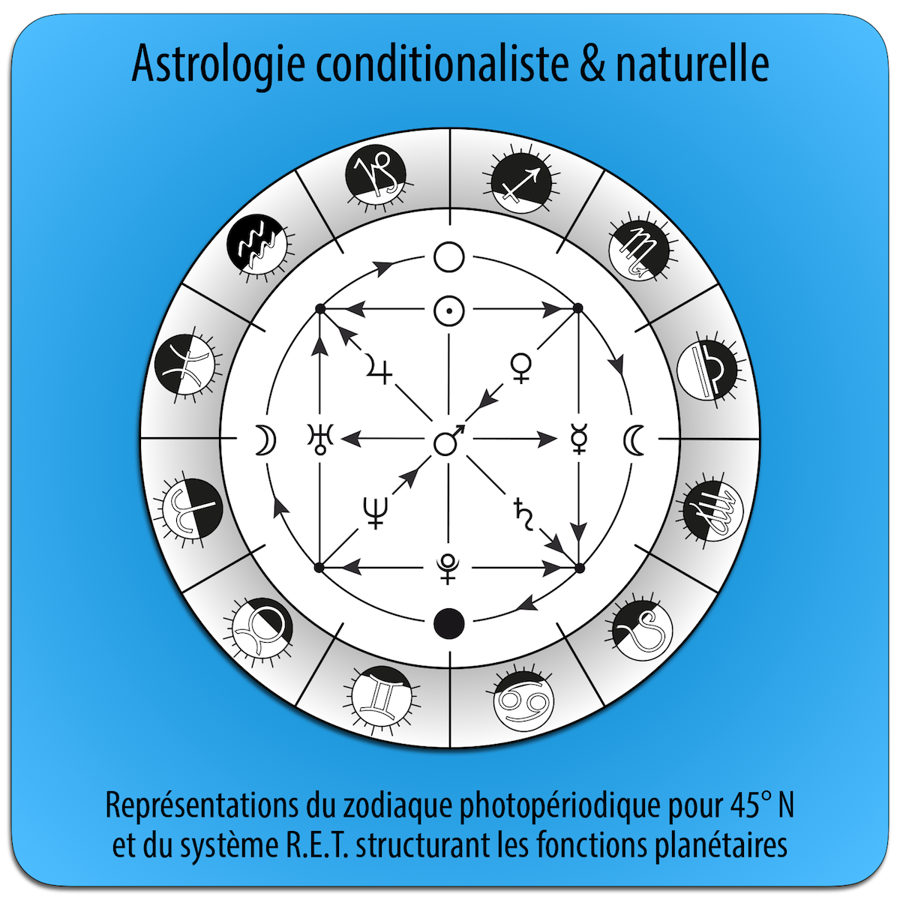
For information, neither of the two Gauquelin spouses ever found the time to pretend to be interested in one way or another in the theories and practices of astro-conditionalism, the existence of which they knew perfectly well since 1955. Very picky and objective when it came to selecting their data sources in order to appear as pure and spotless scientists, they were not at all so when choosing their statistical research hypotheses: from the outset, astro-conditionalism has always been excluded. Similarly, the Gauquelins never cited astro-conditionalism in any of the many works they published. We are entitled to wonder about the reason for such ostracism, when objectively, astro-conditionalism and Gauquelinian astro-statistics renamed late “neo-astrology” or “cosmopsychology” could seem to be on the same side: that of a rational and contemporary approach to astrology that does not take its astronomical foundations lightly.
The reason for this ostracism is prosaic. The Gauquelins (especially Michel) considered themselves the only two-headed crocodile legitimately occupying its neo-astrological backwater. From their perspective, there was therefore no place for another croco, considered a formidable competitor in the competition for official academic recognition that haunted the Gauquelin couple. Michel Gauquelin dreamed of becoming the scientific pope of a neo-astrology of which he would have been the sole, adored and recognized founder. But he considered Jean-Pierre Nicola, discoverer-founder of conditionalist astrology, as the most dangerous of his competitors, even though the latter did not consider himself in competition with anyone.
Jean-Pierre Nicola, who often met him at a time when Gauquelin could believe that his ultimate ambition could be realized, gives his uncompromising testimony on the character: “he never hesitated to move, telephone or write to try to forbid me where I wanted to speak. We should have been on trial and, in accordance with the rules of politeness that these procedures imply, I gave him the address of my lawyer, as well as the name. I may have forgotten the stamp for the reply, but the fact remains that M. Gauquelin did not follow up.”
I myself contacted Michel Gauquelin by mail in 1986, asking him to explain to me clearly the reason for his omission of any reference to conditionalist astrology in his books & works. He replied that this approach to astrology was for him only a theory, and that as such it did not interest him. Inasmuch as “scientist”, he wrote to me, he was only interested in “facts” statistically testable. Which is a simplistic and naive approach to science to say the least. Indeed, on the one hand the theories are “thought facts” which may be subject to statistical controls. And on the other hand there is no “facts”, in the scientific sense of this term, which are not the results of prior theoretical elaborations which will have made it possible to differentiate them from simple perceptions. Gauquelin then assured me that if I offered him an experimental protocol that was not based on any theory, he might be interested. This is called a clever and hypocritical end of inadmissibility but also making fun of the world. Because he could not ignore that all his astro-statistics were based on “facts” identified as such by millennia-old astrological theories.
I obviously did not follow up on this dilatory tactic. Because indeed, as wrote Henri Poincaré In La Science et l’hypothèse, “the road from theory to reality is from theory to model, and then from model to phenomenological law. Phenomenological laws are indeed true of objects in reality – or could be; but the fundamental laws are true only of the objects in the model.” It follows that there are no facts without known or unknown theories behind them and that Gauquelin tried to smoke me out by refusing to test “objects in [a] model”, a model that he refused to test for a reason that has absolutely nothing to do with “scientist”. Statistical or other experimentation is always the test of a theory, and in any “done”, statistical or otherwise, always remains the imprint of a theory even if the latter is not expressly formulated as such.
Fifteen years later I had a interview with Françoise Gauquelin which appeared in Astrologos. I handed her a conditionalist pole to test how she would react. She refused to take it, preferring to dodge the subject by immediately talking about something else. She too did not want to test a theory with a strong and coherent model, and preferred to do small-time statistics by picking up alleged “facts” astrological without worrying about the… “done” that they had been previously elaborated by ancient theories whose epistemological reality was as indifferent to her as to her ex-husband. We are here at the heart of the Gauquelin device: simplistic frequentist statistics put at the service of a recovering and verifying empiricism without overview or common thread. It is also remarkable to observe, in this respect, that the Gauquelins did not propose any explanatory theory of the results of their “discoveries”.
To end in style, the diagram below is one of surprising results of a statistical study on the signs of the zodiac in correspondence with various subjects commissioned by the Billionaire playboy Gunter Sachs, who had infatuated with astrology. It was produced by Rita Küntzler, a statistician with a degree from the University of Münich. In the afterword to the work mentioned below, she humorously points out that the cost of this study was “just below the factory price of a Porsche 911, at the price in effect in 1977”, which in 2019 occasionally sells around 85,000 €. Not all statisticians agree with some of the sources, methods and conclusions of this study (eg. Dean & Ertel), and one of the most critical is… a statistician astrologer !
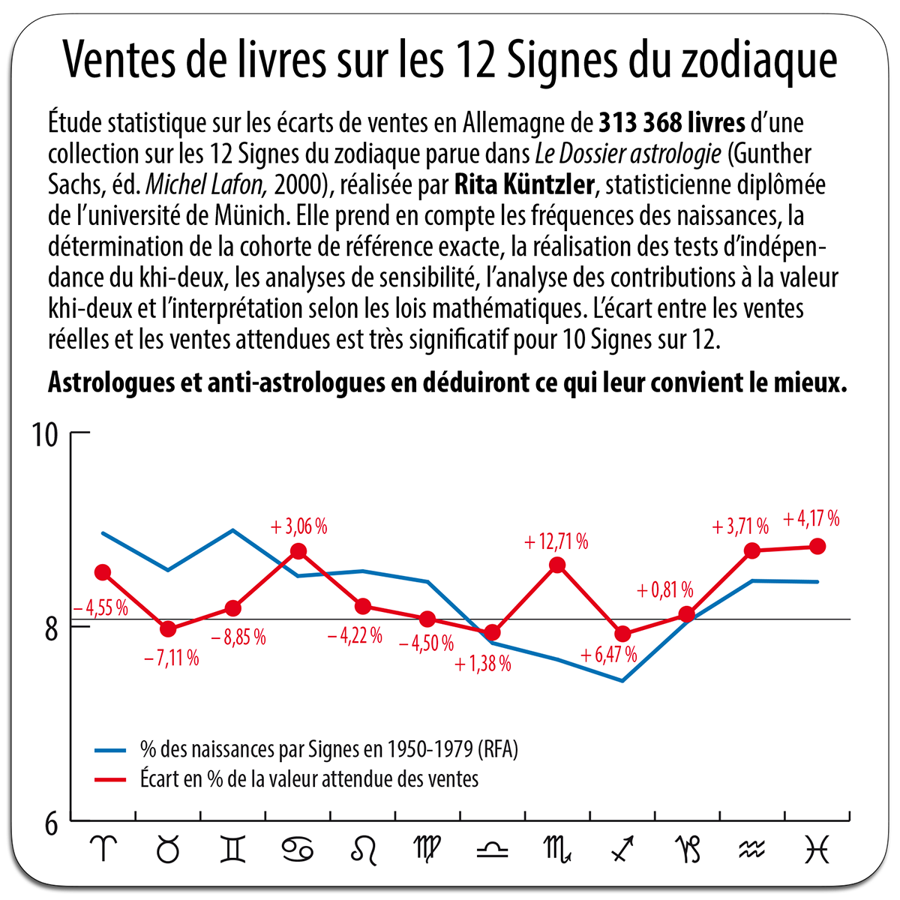
Dijon, 14th June 2019.
▶ The specific issues of astrological statistics
▶ Tests et prétextes : comment démonter l’astrologie ?
▶ Astrologie canine, astrologie cynique ? À propos d’une expérience statistique sur des chiens
▶ Carlson’s “experiment”: an example of anti-astrologist quackery
▶ The Petiot affair and the “Barnum effect” or the anti-astrologer circus
▶ Le problème des jumeaux en astrologie
▶ Uranus astronomique
▶ Sun-Uranus aspect
▶ Mars-Saturn aspect
▶ Astrologie et astrologies : écoles, courants et chapelles
▶ Results of conditionalist astrology
▶ Results of traditional astrology
▶ Results of statistical astrology
▶ The world according to Claudius Ptolemy, astronomer-astrologer and lighthouse of Alexandria
▶ Ptolemy and the error of the senestrogyrate Houses
▶ Introduction to the comparative results of astrologies
▶ Anar-show en hommage à Paul Feyerabend
▶ Ike Uncyfar and Astro-statistics on video

Les significations planétaires
par
620 pages. Illustrations en couleur.
La décision de ne traiter dans ce livre que des significations planétaires ne repose pas sur une sous-estimation du rôle des Signes du zodiaque et des Maisons. Le traditionnel trio Planètes-Zodiaque-Maisons est en effet l’expression d’une structure qui classe ces trois plans selon leur ordre de préséance et dans ce triptyque hiérarchisé, les Planètes occupent le premier rang.
La première partie de ce livre rassemble donc, sous une forme abondamment illustrée de schémas pédagogiques et tableaux explicatifs, une édition originale revue, augmentée et actualisée des textes consacrés aux significations planétaires telles qu’elles ont été définies par l’astrologie conditionaliste et une présentation détaillée des méthodes de hiérarchisation planétaire et d’interprétation accompagnées de nombreux exemples concrets illustrés par des Thèmes de célébrités.
La deuxième partie est consacrée, d’une part à une présentation critique des fondements traditionnels des significations planétaires, d’autre part à une présentation des rapports entre signaux et symboles, astrologie et psychologie. Enfin, la troisième partie présente brièvement les racines astrométriques des significations planétaires… et propose une voie de sortie de l’astrologie pour accéder à une plus vaste dimension noologique et spirituelle qui la prolonge et la contient.
Téléchargez-le dès maintenant dans notre boutique

Pluton planète naine : une erreur géante
par
117 pages. Illustrations en couleur.
Pluton ne fait plus partie des planètes majeures de notre système solaire : telle est la décision prise par une infime minorité d’astronomes lors de l’Assemblée Générale de l’Union Astronomique Internationale qui s’est tenue à Prague en août 2006. Elle est reléguée au rang de “planète naine”, au même titre que les nombreux astres découverts au-delà de son orbite.
Ce livre récapitule et analyse en détail le pourquoi et le comment de cette incroyable et irrationnelle décision contestée par de très nombreux astronomes de premier plan. Quelles sont les effets de cette “nanification” de Pluton sur son statut astrologique ? Faut-il remettre en question son influence et ses significations astro-psychologiques qui semblaient avérées depuis sa découverte en 1930 ? Les “plutoniens” ont-ils cessé d’exister depuis cette décision charlatanesque ? Ce livre pose également le problème des astres transplutoniens nouvellement découverts. Quel statut astrologique et quelles influences et significations précises leur accorder ?
Enfin, cet ouvrage propose une vision unitaire du système solaire qui démontre, chiffes et arguments rationnels à l’appui, que Pluton en est toujours un élément essentiel, ce qui est loin d’être le cas pour les autres astres au-delà de son orbite. Après avoir lu ce livre, vous saurez quoi répondre à ceux qui pensent avoir trouvé, avec l’exclusion de Pluton du cortège planétaire traditionnel, un nouvel argument contre l’astrologie !
Téléchargez-le dès maintenant dans notre boutique